
Featured Artworks
-


Male Leader Mask
Northwestern Grassfields: Oku
Wood, human hair, pigment, feather, sap
mid-18th centuryMasks such as this are used to commemorate deceased Fons (kings) and celebrate the enthronement of the successor.
The mask has deep eyes with kaolin pigment; the coiffure is composed of human hair applied with sap (leh) from Grassfields trees. The sap is believed to act as protection against bad spirits. The feather is a symbol of the title holder (leader). It possibly represents the face of the ancestral founder of the kingdom.
-


Mask
Southwestern Forest: Banyang
Wood, antelope hide, fiber, bamboo
early 20th centuryThe mask itself was carved from wood and then covered with antelope skin, it adorns a fiber coiffure. Over time, the mask developed a deep red-brown color from normal wear and tear as well as from oils and other substances that are applied before and during ceremonies. Close attention was paid to the overall details of the mask: bamboo teeth, impressions made in the leather to represent details of the face, moustache, beard and eyebrows.
-
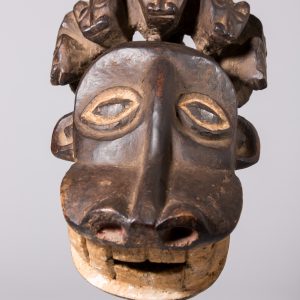
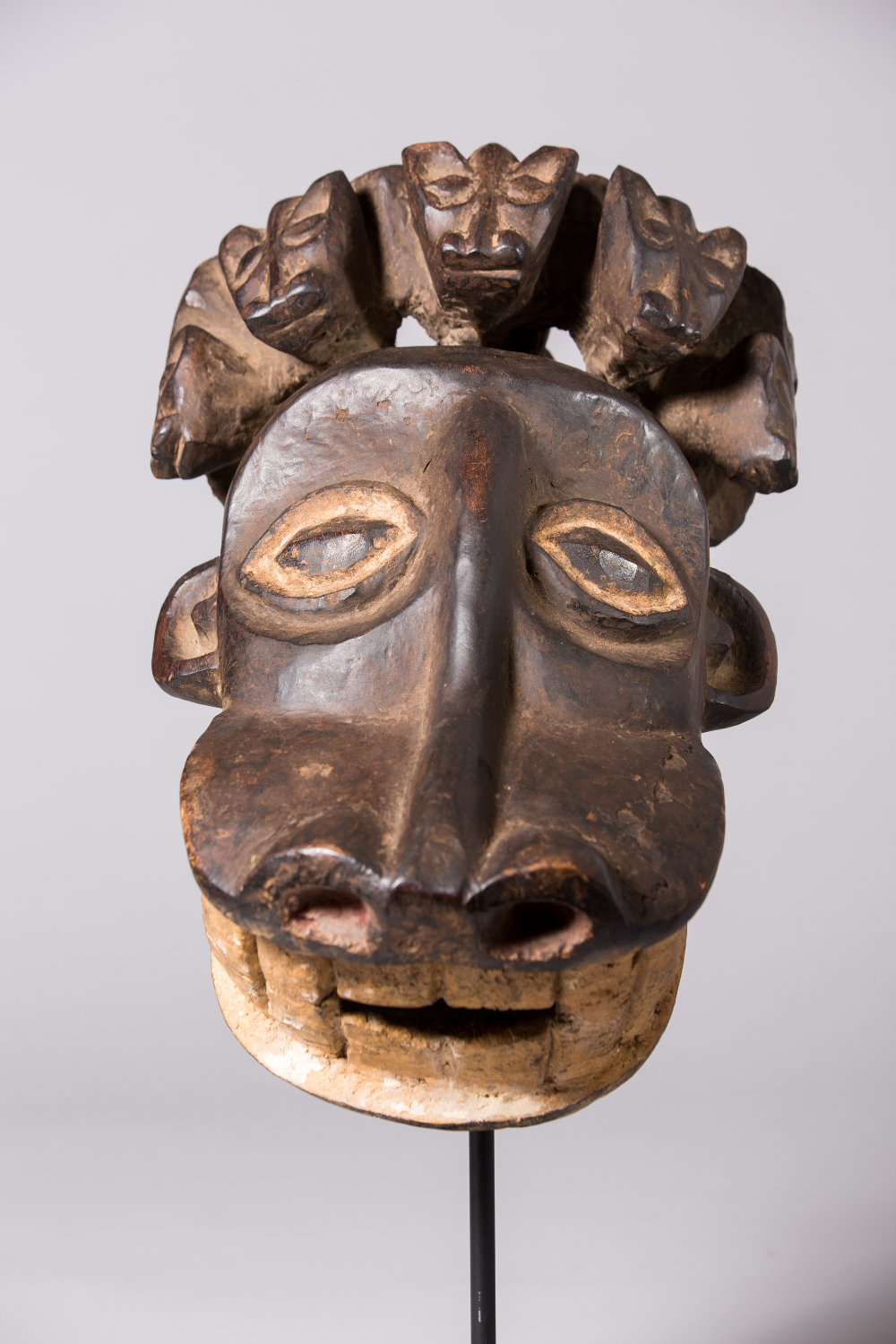
Helmet Mask
Northwestern Grassfields: Kom
Wood, pigments
early 20th centuryThis mask represents a buffalo with five leopards forming a crown atop its forehead. Along with the red pigment found in the nostrils and bared white teeth these symbols signify great strength and fury.
-

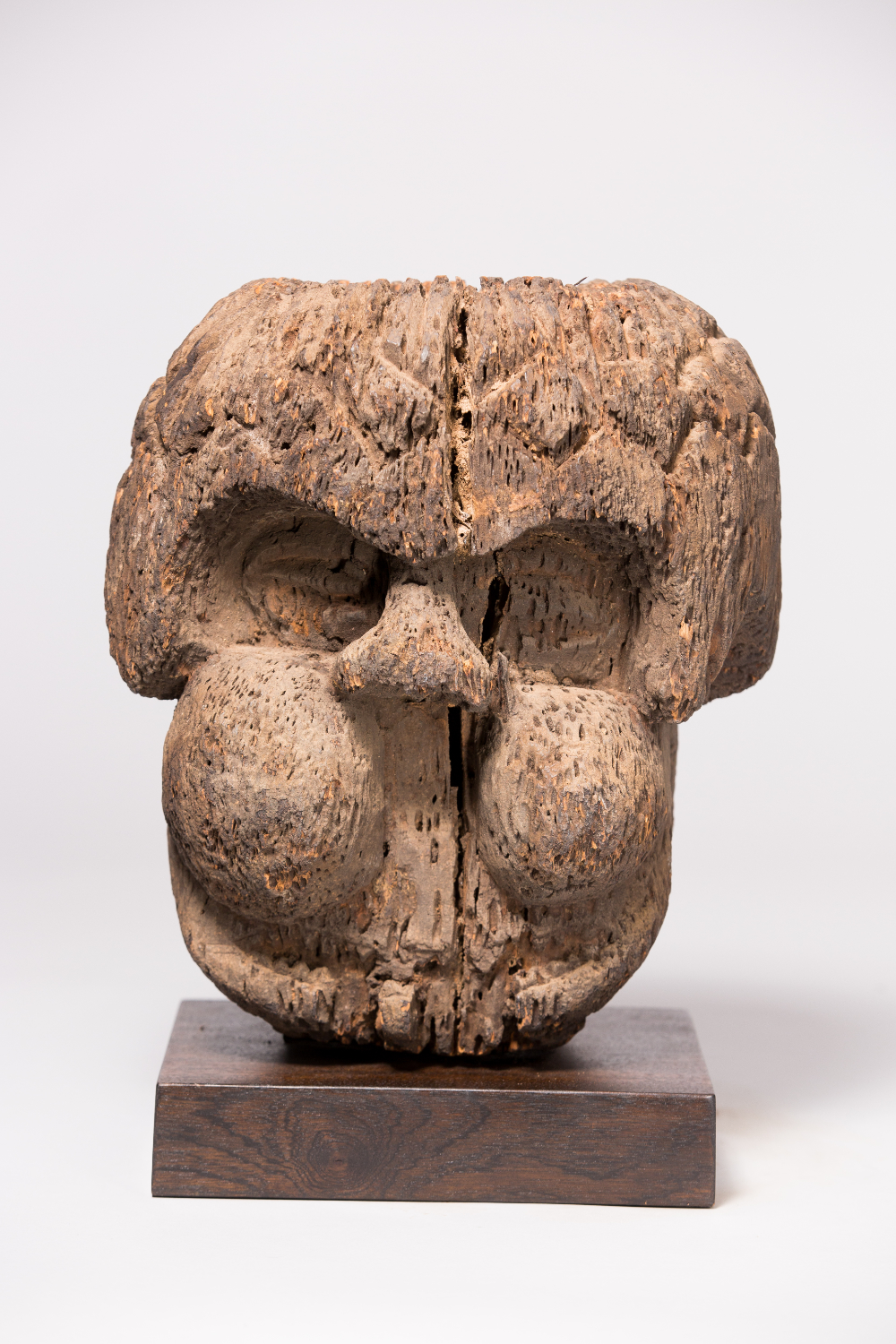
Janus Shoulder Mask, Troh Society
Western Grassfields, Bamileke: Bangwa
Wood
early 19th centuryCarved from the palm tree, this particular mask has full, round high puffy cheeks. The very deep set eyes are a common characteristic of Troh Society masks. They are worn during the Fon’s (king’s) funeral and play a major role during the enthronement of the successor. The mask’s strong unity of form exudes the intelligence of the ages.
-

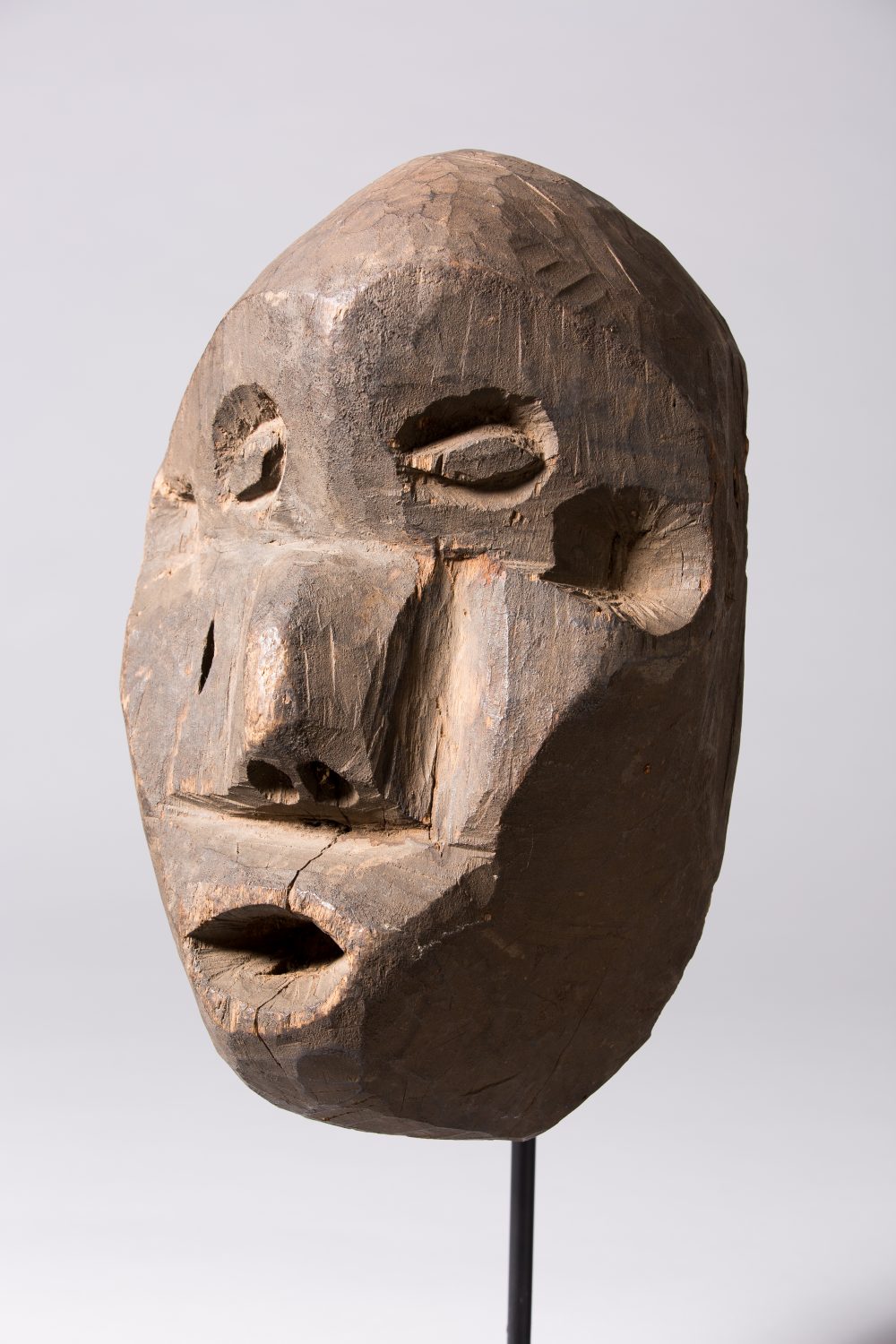
Mask
Western Grassfields, Bamileke: Bangwa
Wood
early 20th centuryFor a very intentional reason, now unknown to us, the carver made the eye on the left side slant upwards as well as a slight tilt of the mouth. One can only wonder why the carver chose this “expressionistic†path.
In the Bamileke tradition, carvers usually represented leaders or high-ranking people just as they looked; therefore, this mask may contain the important facial traits of a particular leader ―with his eyes not quite in alignment and a mouth not quite horizontal.
However, among the Bangwa Kingdom carvings, forms are often at their most basic representation, and symmetry and perfection are not as important as surprising forms, action and proportions, which often create a more emotional and powerful statement.
-
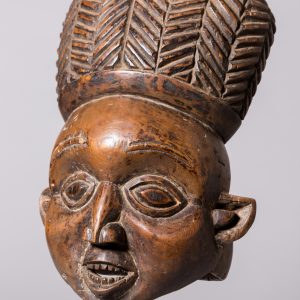

Holder's Mask
Western Grassfields: Babanki
Wood
early 20th centuryThis dynamic mask wears a prestige cap and represents a notable figure (title holder) within the Kingdom. The expression on the face with its open mouth represents singing during a festival or funeral.
-


Mask, Troh Society
Western Grassfields, Bamileke: Bangwa
Wood
late 18th centuryThe face of founding ancestors with puffy cheeks and beard surrounding the face, and was used during funerals for the deceased Fon (king) and enthronement of the new.
-


Male Figure
Northwestern Grassfields: Mambila
Wood, pigments
early 19th centuryThis fragmented figure represents an old style of carving which emphasizes the ceremonial movement of the body. The hands are on the chest in a position of prayer, and the position of the mouth with the exposed teeth showing suggests singing. The cylindrical, projecting eyes are also a stylized characteristic of Mambila carving. Overall, even with the erosion of the legs (once zig-zagging), the body still commuicates a powerful statement of motion and strength.
Many of the Mambila figures were used for protection and kept in a little hut within the compound. Each family has their personal statues. They believe that they would be protected from evil and bad spirits. Often the object received sacrifices and prayers from the owners.
In African culture, erosion of a sculpture does not necessarily destroy it, and that is why it is not usually discarded. It would still be used and might, in fact, have greater powers. The erosion usually enhances it, giving it more history and power.
-
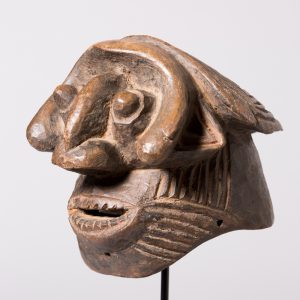
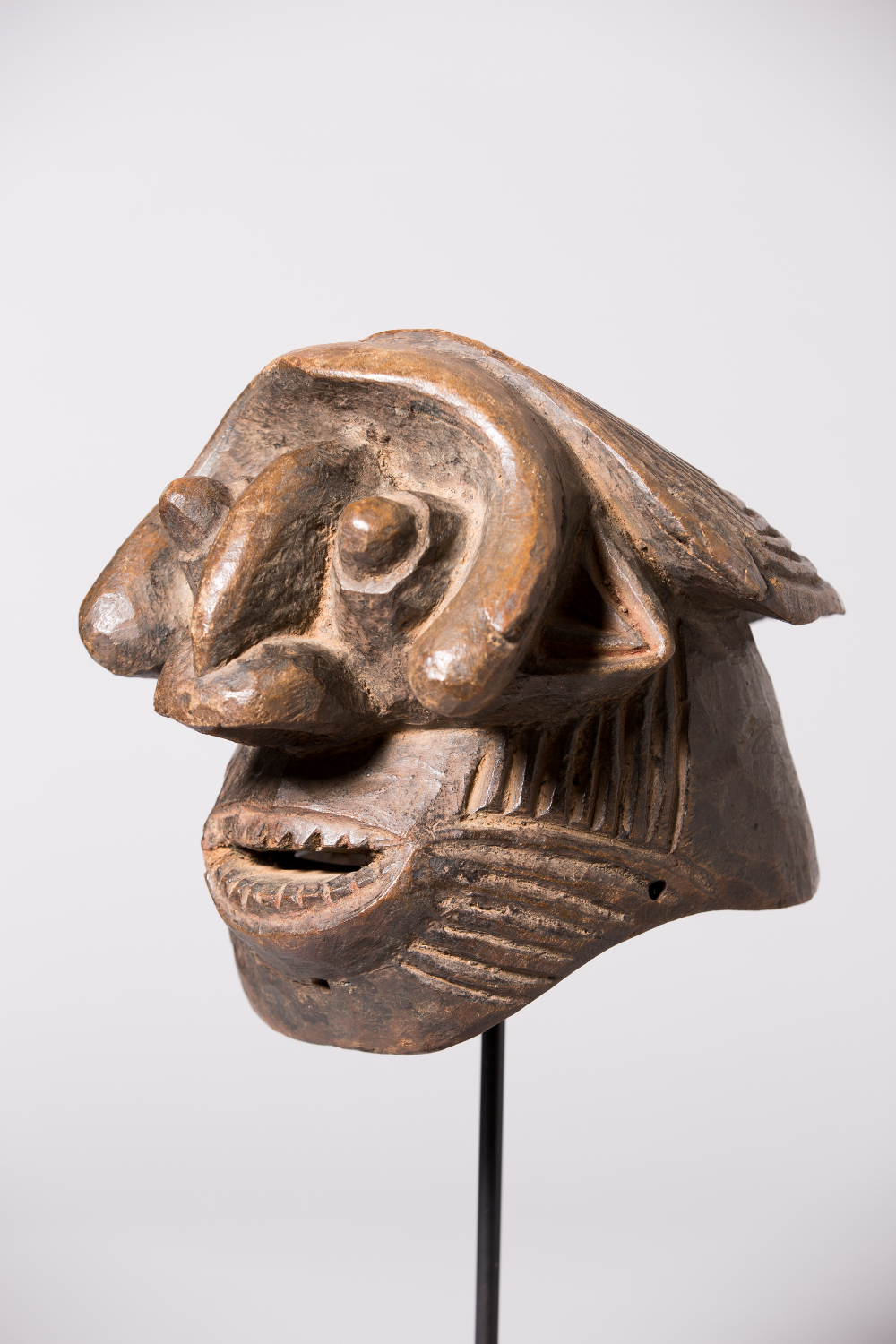
Male Leader Mask
Western Grassfields: Wum
Wood
early 20th centuryThis mask represents a fon (king) or title holder. He wears a prestige hat and has puffy cheeks on the sides of the bulging eyes, looking up to the sky – the unknown. His thick nose depicts strength. The lines on the side of the mask represent a beard which depicts old age (knowledge).
The chief has an open mouth and a row of teeth which represents speaking or singing during a royal celebration.
This early mask, in its simplicity, arrives at the essence of the carver’s statement: power and knowledge.
-

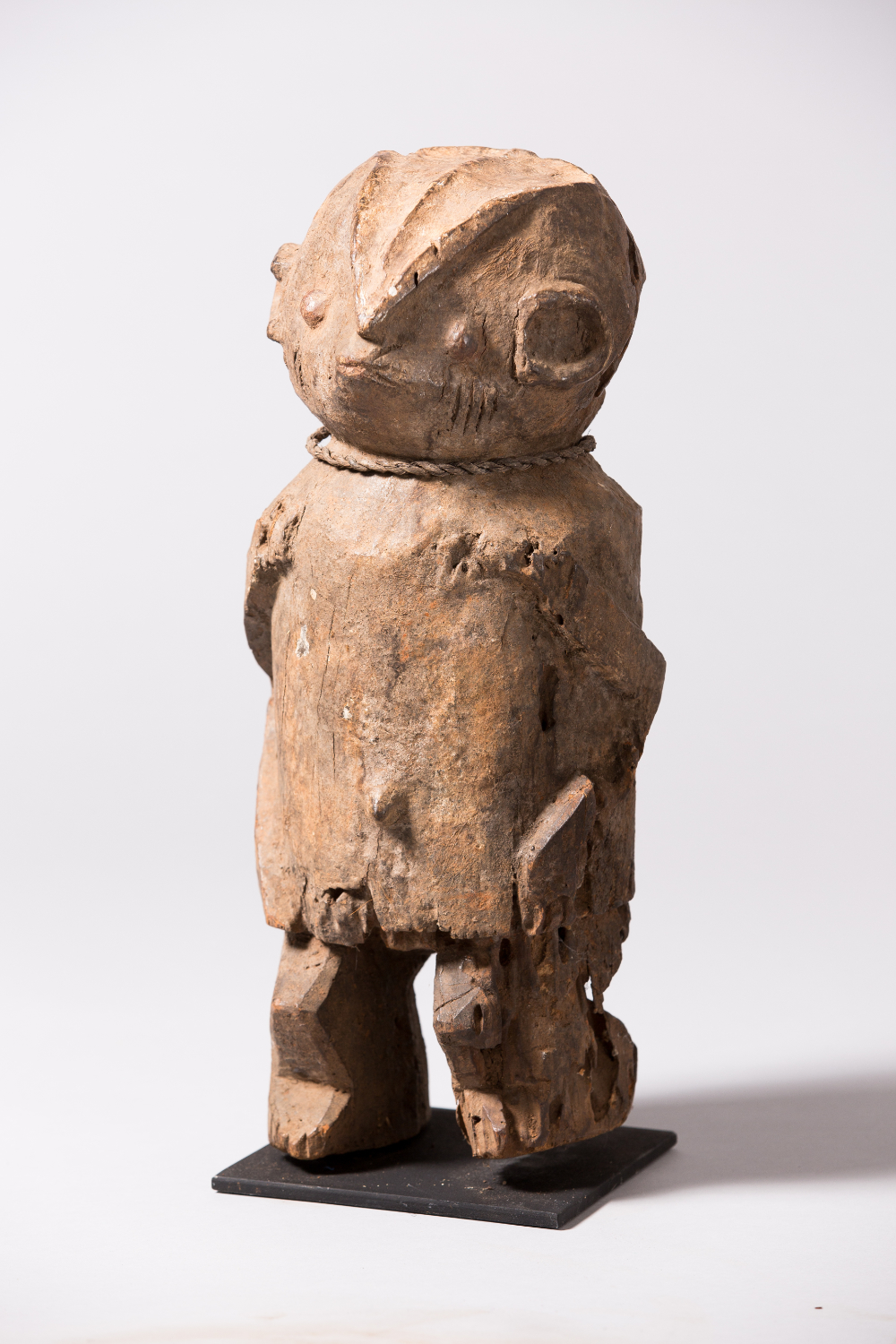
Male Figure
Northwestern Cameroon: Kaka
Wood, twine
early 20th century -

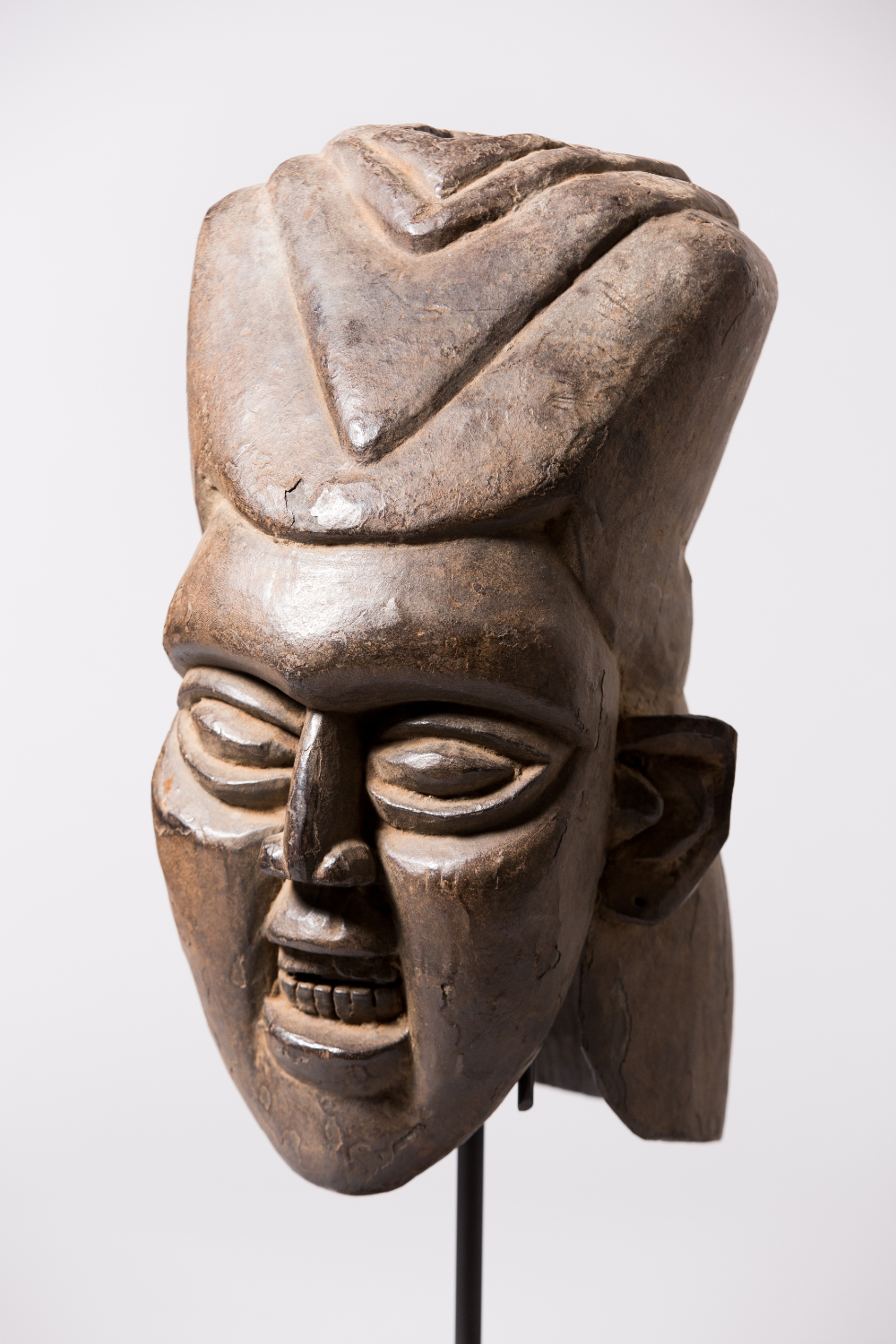
Commemorative Figure
Northwestern Grassfields: Kambe
Wood
early 19th centuryThe Fon (king) is wearing a prestige cap and a leopard tooth necklace, all carved from the same piece of wood. He is holding a carved buffalo motif palm wine cup and wears a royal bangle on his left hand.
Most leaders, being powerful, are depicted with large heads, this one with a moustache and beard.
Such figures are kept in the royal palace and are shown publically during special festivals. For instance, when a chief passes away, the important sculptures are taken out for the public to see, as they represent the past Fons. -
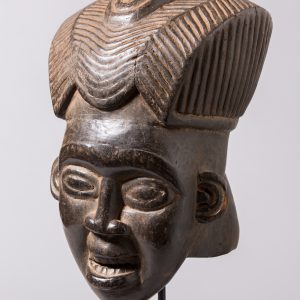

Helmet Mask
Northwestern Grassfields: Kom
Wood
early 20th century -

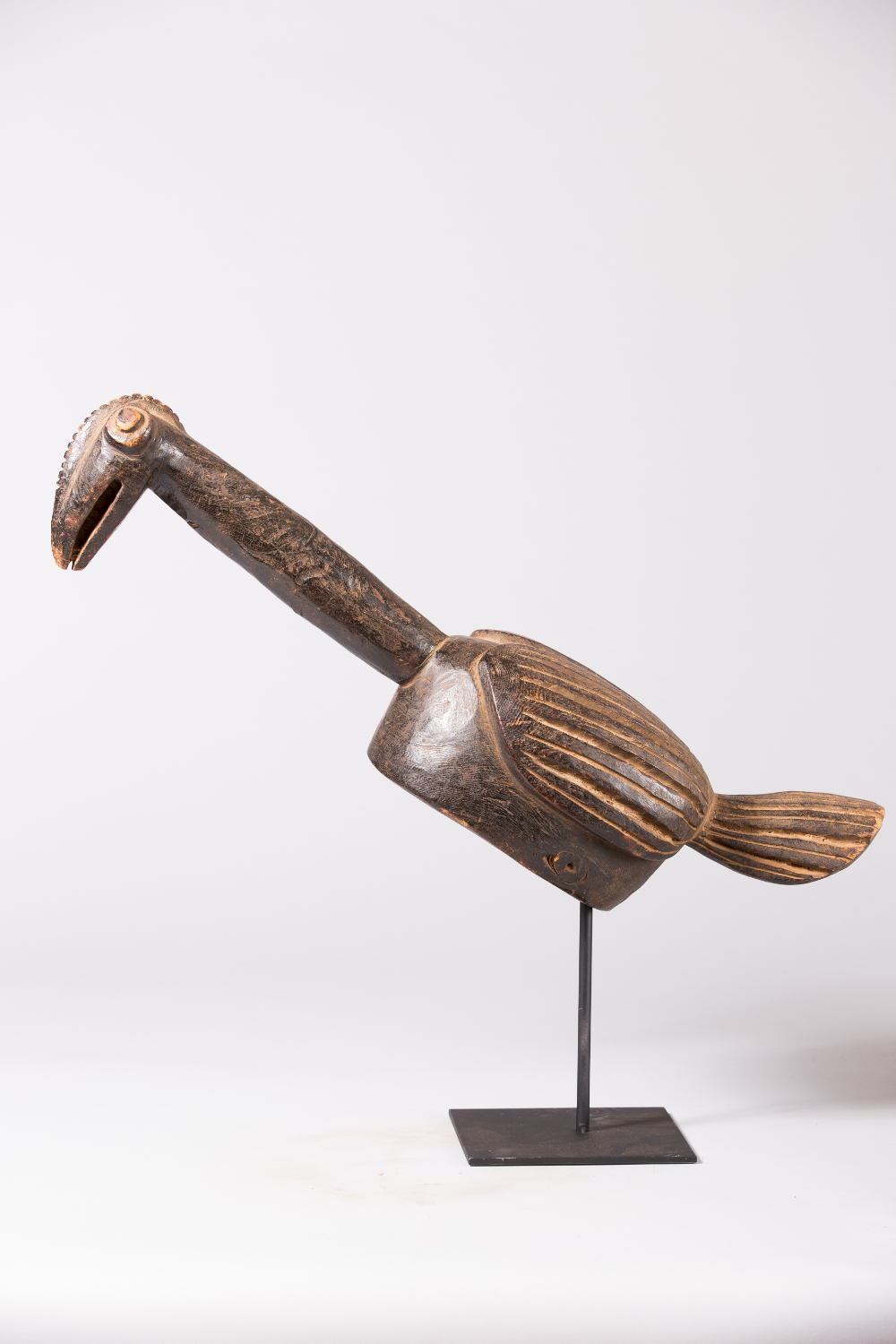
Helmet Mask
Northwestern Grassfields: Oku
Wood
early 20th century -
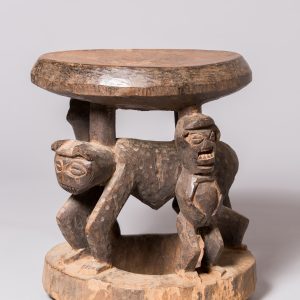
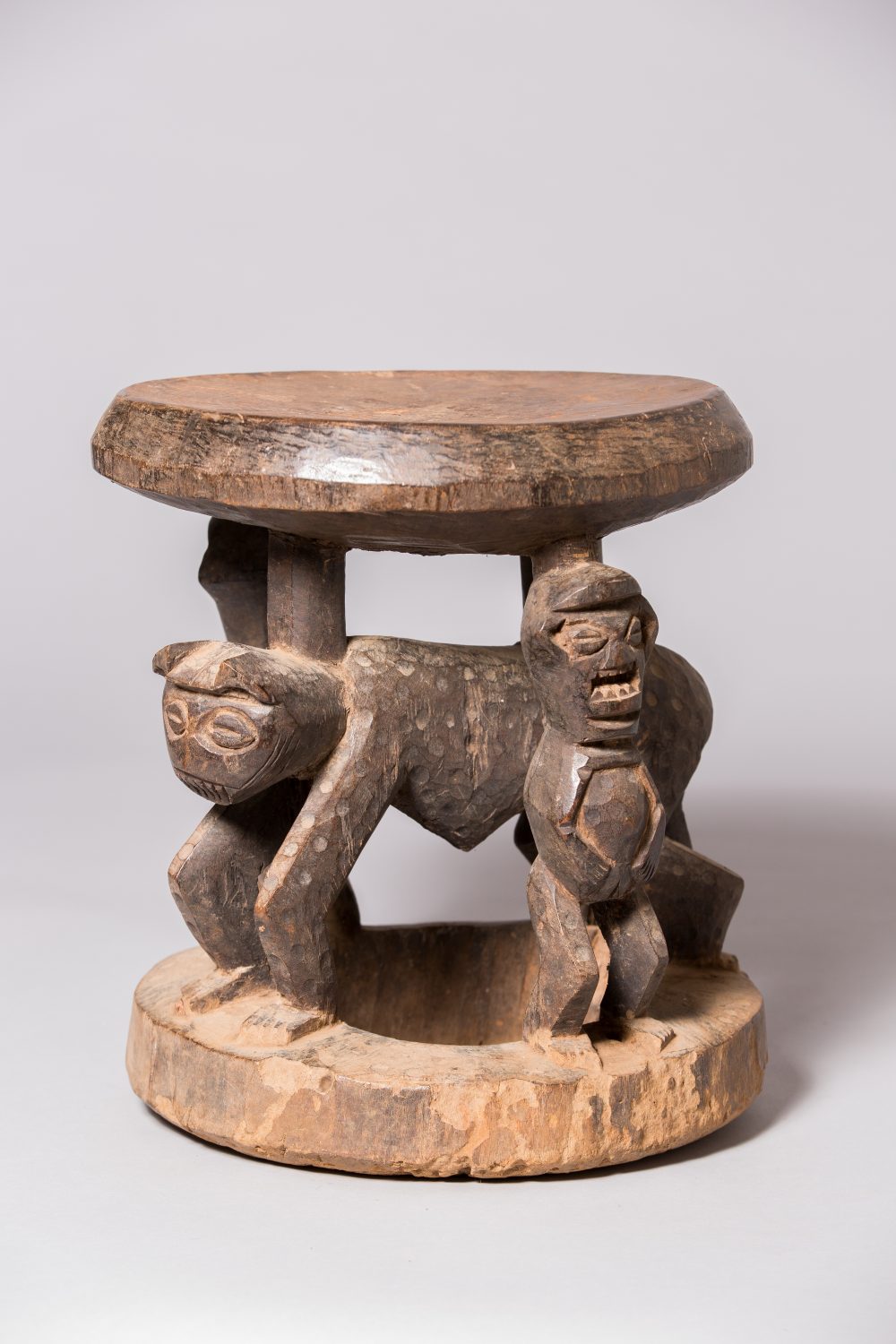
Stool
Western Forest: Widekum
Wood
20th centuryOne figure is anthropomorphic, with a leopard’s body and a human face. The other figure is a person performing a ritual act. They are surrounded by two giant earth spiders symbolizing wisdom.
-

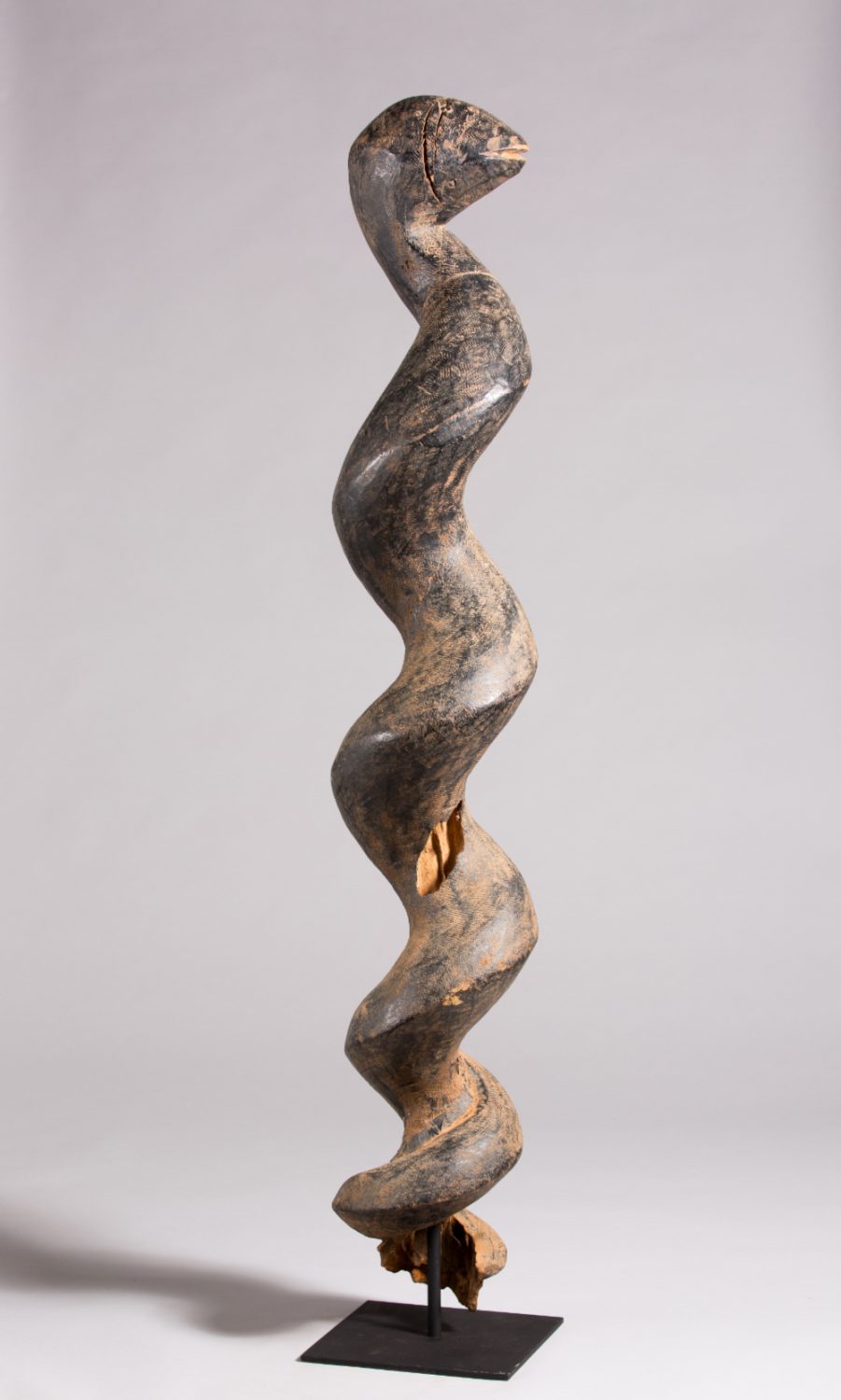
Guardian Post
Western Grassfields, Bamileke: Bangwa
Wood, pigment
19th centuryThis very rare guardian post is in the form of a coiled snake, and carving it in this multiple series of curves is in itself a tour de force. This sculpture is complete, the bottom eroded from being planted in the ground for a long time during the grieving period.
The Bamileke believe that the snake is a carrier of the soul into the after life.
-

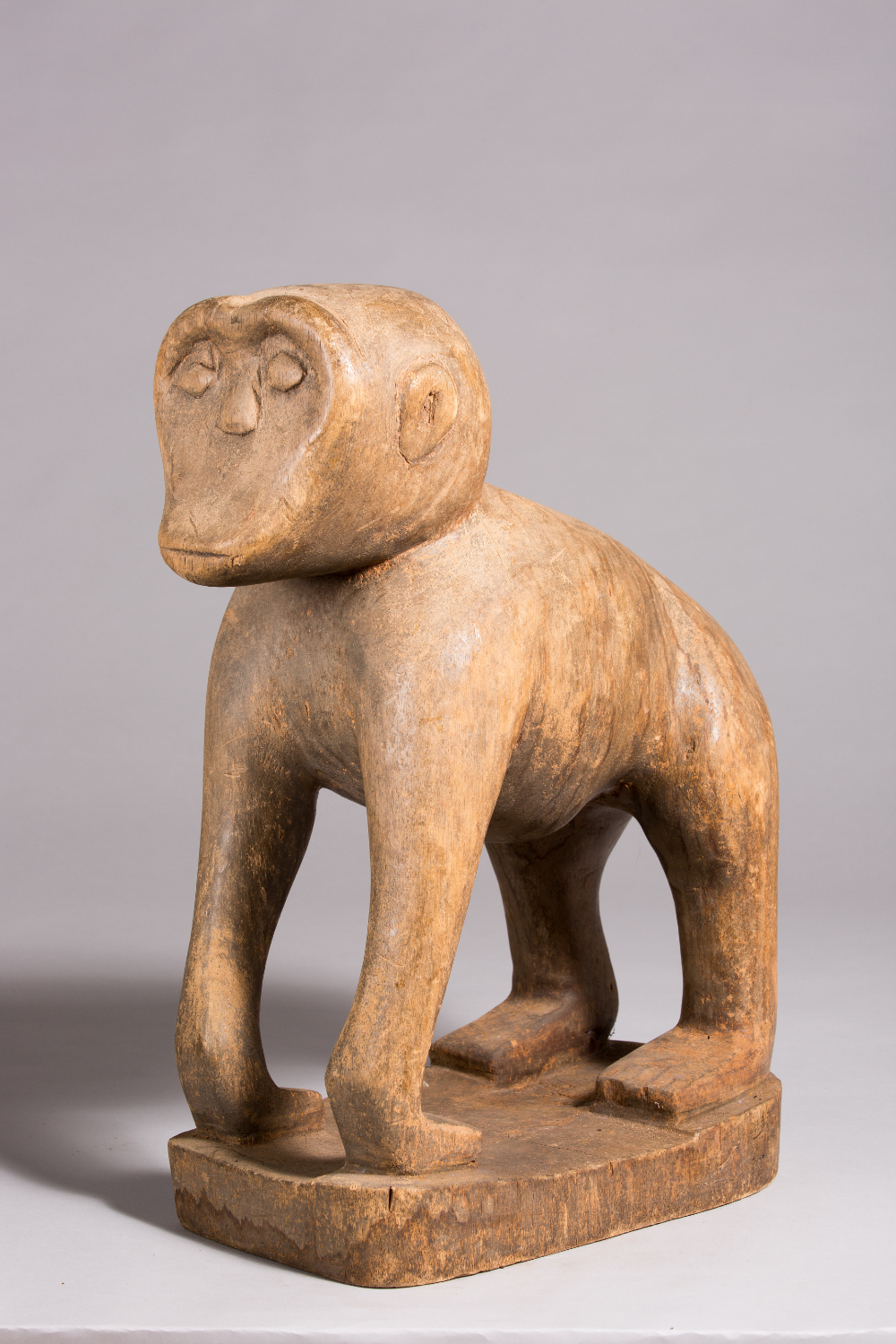
Figure, Gorilla
Southwestern Forest: Bulu/Fang Wood
early 20th century -
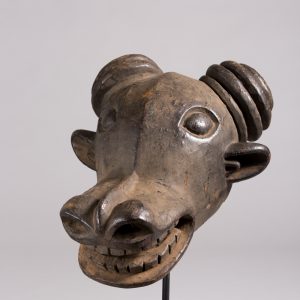

Helmet Mask
Northwestern Grassfields:Â Oku
Wood, sacrificial materials
early 20th centuryBuffalo or ram mask with stubby horns and flaring nostrils. The hard, black patina is covered with sacrificial material.
-
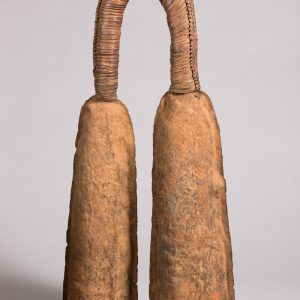

Double Gong
Kwifoyn Society Western Grassfields: Bamileke
Iron, cane
early 20th century -
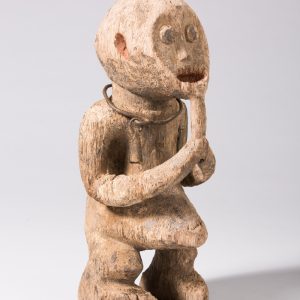

Female Figure
Northern Grassfields:Â Mambila
Wood, metal, pigment
early 20th centuryThe patina is an ancient one implying many things, i.e. wise and powerful. As old sculptures develop ancient patina from the elements (wind, rain, sun usage and sacrificial material) it gains power and wisdom from age. This figure in particular has that type of profound patina, which has become an aesthetic; and thus gives the piece even more value and respect.
The female ritualist is playing a flute during a ceremony. The zig-zag on the figure is one of the great dynamics of Mambila carving.
-
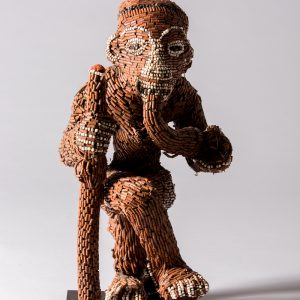

Seated Commemorative Figure
Western Grassfields: Bamileke: Dschang
Wood, beads, thread
20th centuryThe small, commemorative figure represents a Fon (king) seated on a stool covered in imported beads which symbolizes prestige. The fon holds a ritual staff and smokes a pipe while crossing his legs. The crossing of the legs is a position only allowed for the fon; title holders are permitted as well, but outside the palace. This gesture represents a Fon having a formal or ritual meeting.
-


Male Mask
Northwestern Grassfields: Oku
Wood
early 20th century -

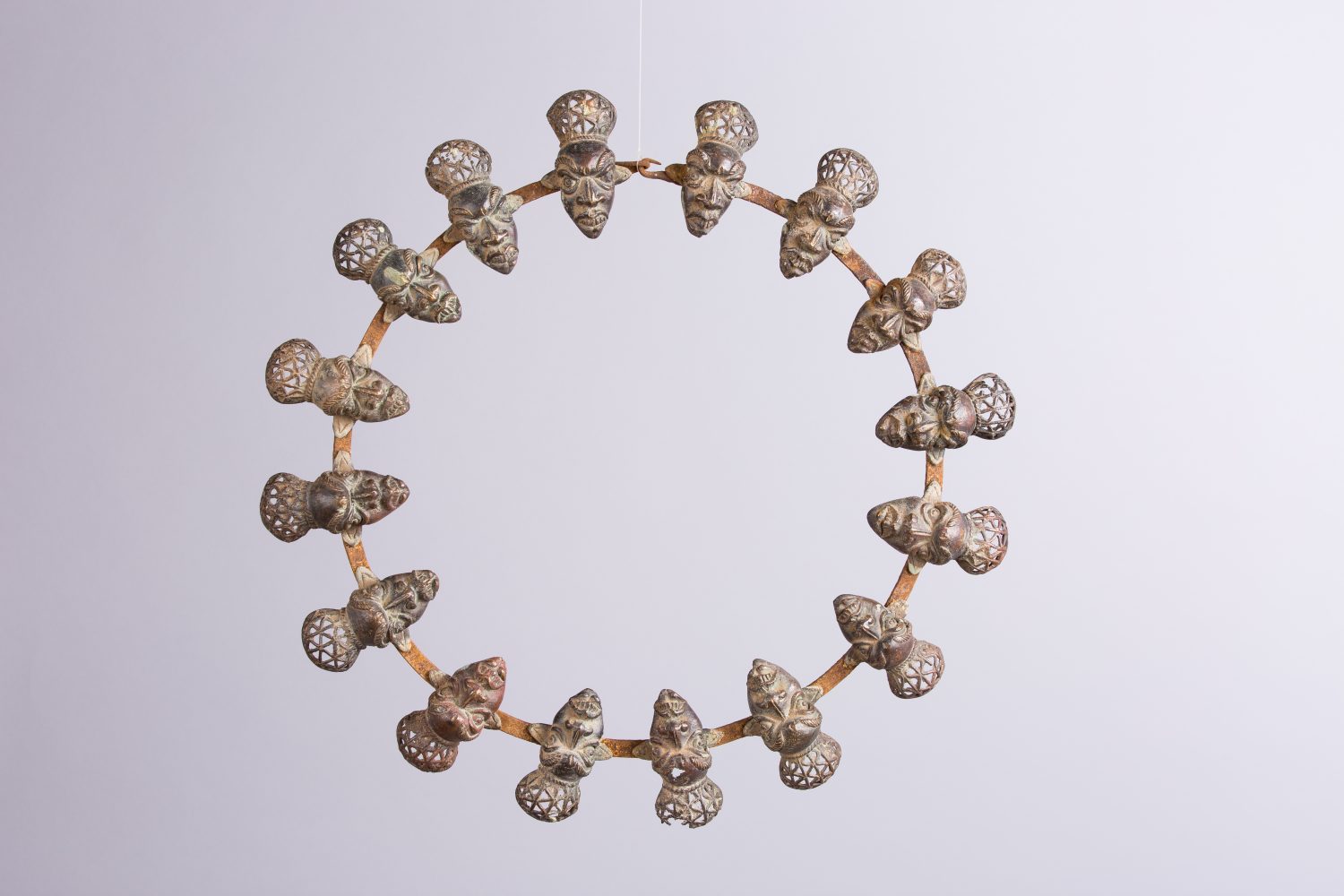
Notable's Neckring (Mbga Mbga)
Eastern Grassfields, Bamum:
Foumban
Brass, copper
20th centuryRings such as this would be worn by members on the council and visiting dignitaries as tokens of honorary membership.
-


Mask, Ku'Ngang Society
Western Grassfields, Bamileke: Bandjoun
Human hair, animal horns, cowrie shells, textile
early 19th century -


Male Mask
Western Grassfields, Bamileke: Bangwa
Wood, hide, fur, metal
early 19th century -


Commemorative Royal Headpiece (Shrine)
Western Grassfields: Balikumbat
Brass, copper
18th centuryUsing the lost-wax casting method, this old and delicately detailed mask is a masterful example of the ironwork produced in Cameroon. A common characteristic is portrayed here by the large puffy cheeks representing wisdom, and the chameleon crown which symbolizes the virtuous trait of awareness.
The chameleons are emerging out of the royal crown which has the form of a ritual ceramic “country” pot. The pot contains all ritual and sacrificial materials connected with the living and the deceased ancestors.
This headpiece was used mostly on a shine, but taken out and worn during special ceremonies.
-


Helmet Mask
Western Grassfields: Bafanji
Brass, copper, pigment
18th centuryThis mask was kept in a secret house in the palace, with a giant lizard on the top of the head representing awareness.
-


Male Mask
Western Grassfields, Bamileke: Bangwa
Wood, hide, fur, metal
early 19th century -
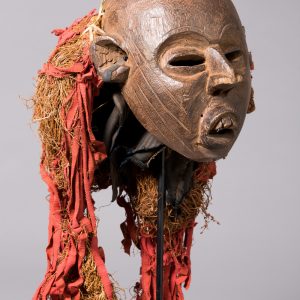
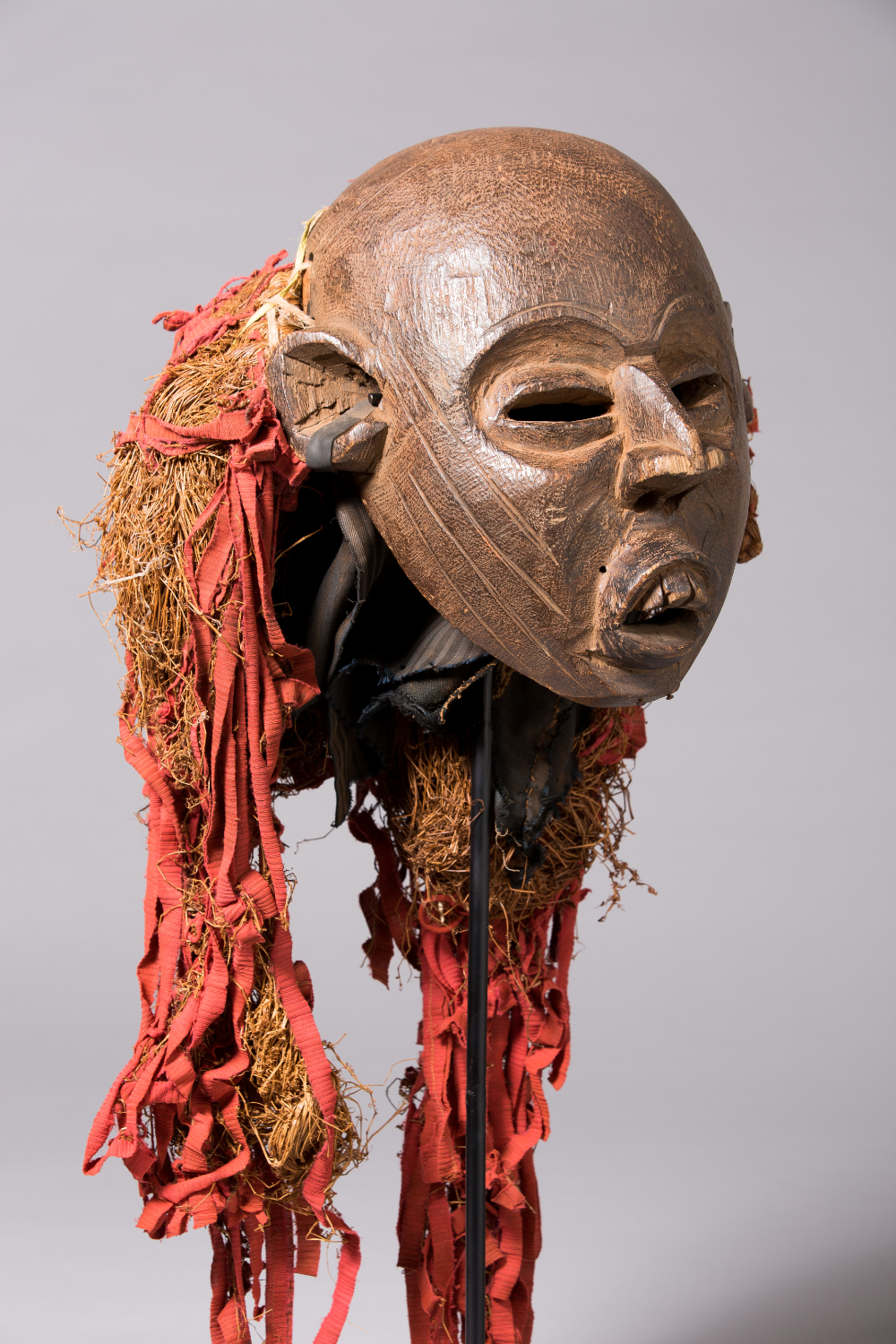
Male Figure
Western Grassfields, Bamileke: Bangwa
Wood, medicinal substances
early 19th century -

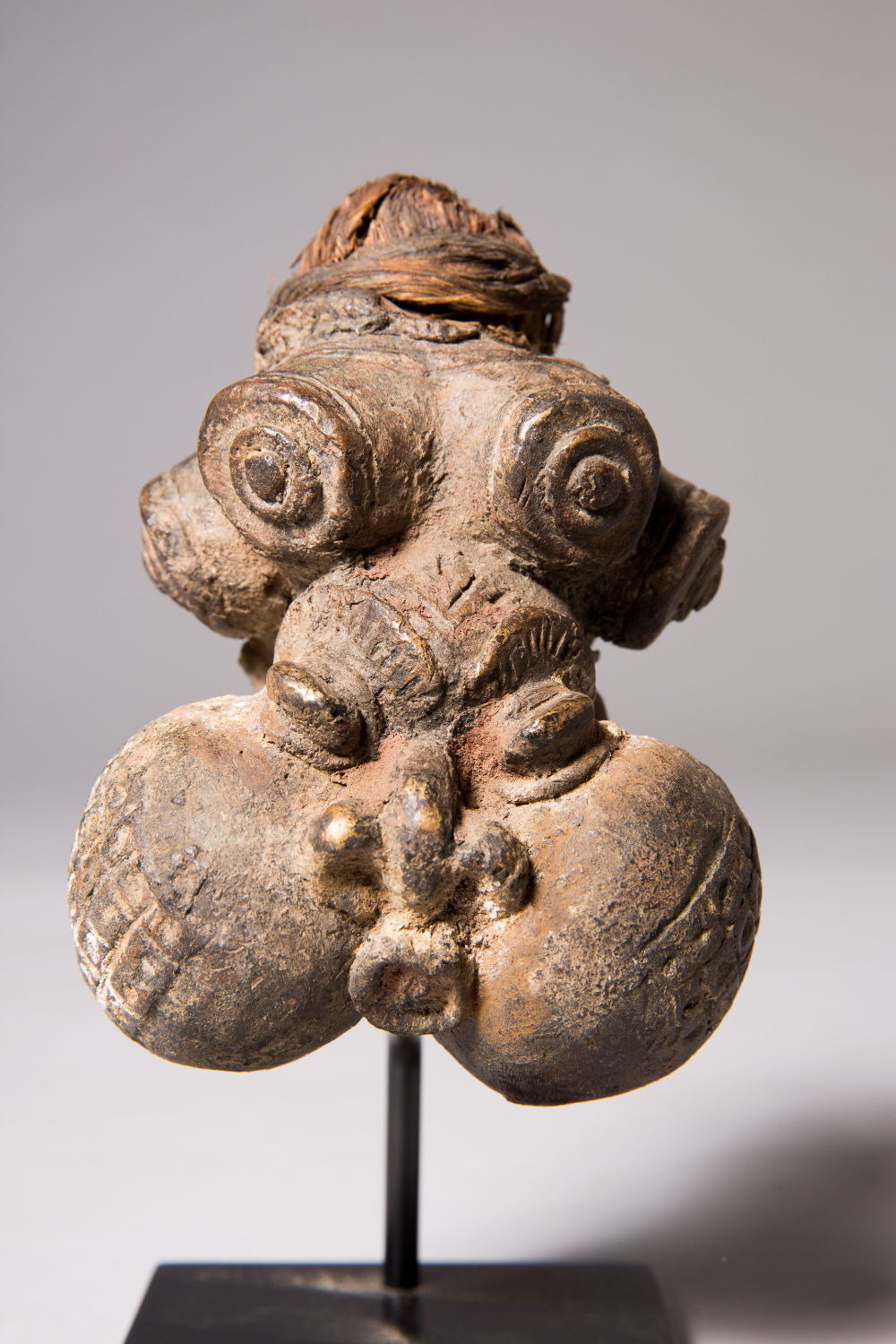
Notable's Pipe
Western Grassfields
Copper, straw, medicinal substances
early 20th centuryThis pipe was used for smoking and contained medicines that protected and helped country warriors to be invisible during war time to defeat their enemies. The puffy cheeks and notable hat are familiar charateristics of a prestigous figure within the community.
-
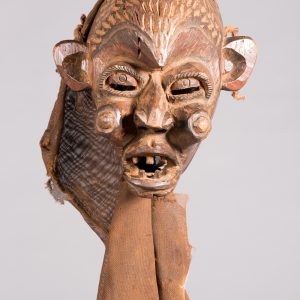

Mask, Night Society
Western Grassfields, Bamileke: Bangwa
Wood, textile
early 20th century -


Mask, Ku N'gang Society
Western Grassfields, Bamileke: Bangwa
Wood, human hair, textile, metal, pigment, paint
early 20th centuryThe face of this mask has black and red paint on surface, and the coiffure is an assemblage mix of various cloths, slices of goat hide, human hair, and owl wings on both sides of the ears which symbolize vision and power.
-
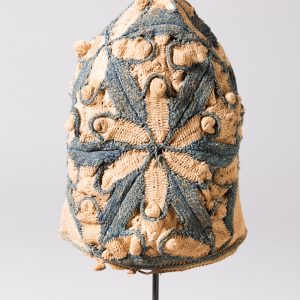
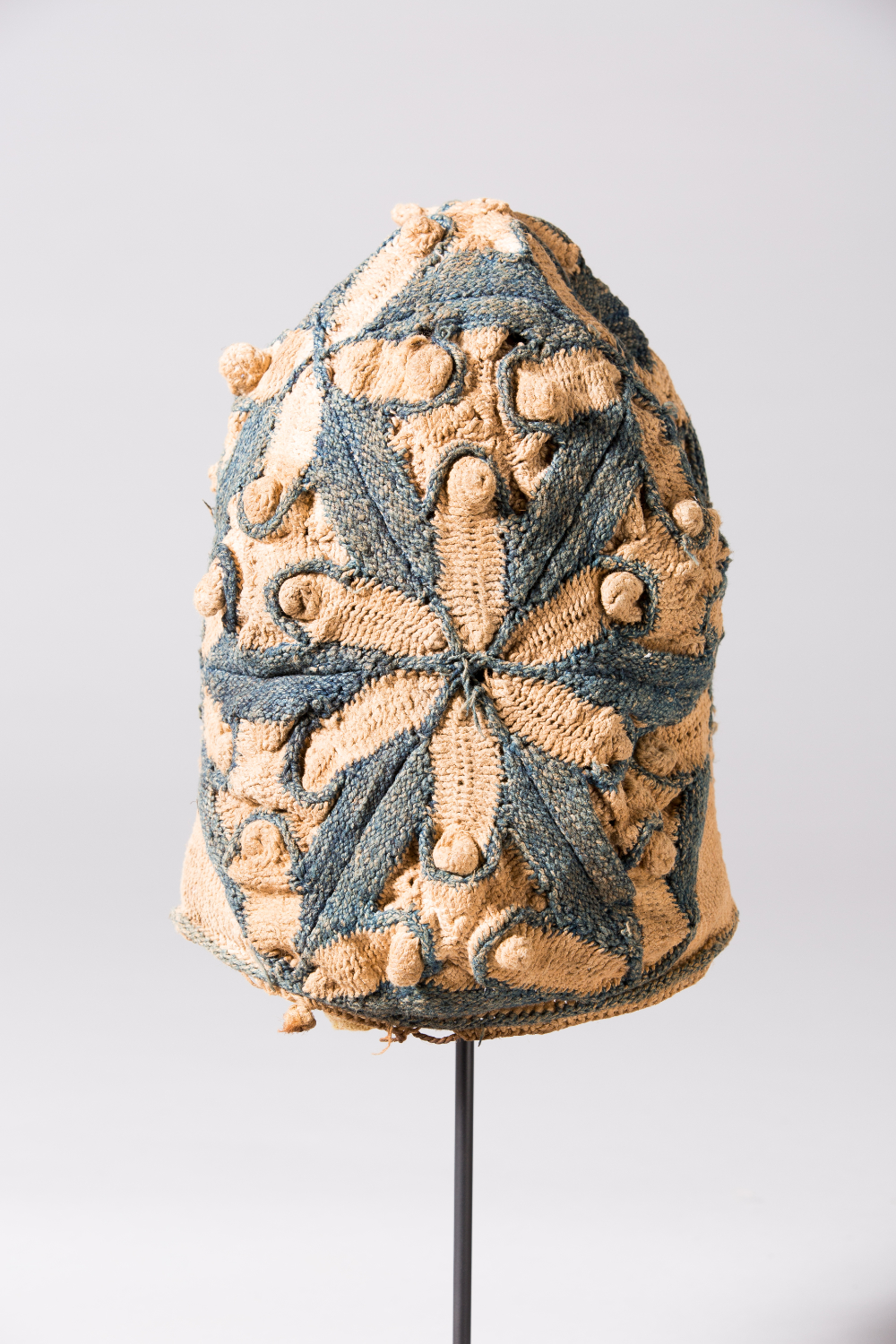
Chief's Ceremonial Stool
Western Grassfields, Bamileke: Bangwa
Wood
early 20th century -
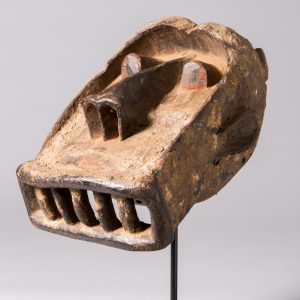

Helmet Mask
Western Grassfields: Wum
Wood, pigment
early 19th century -
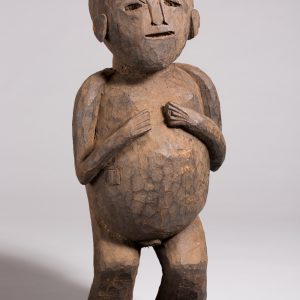

Male Commemorative Figure
Western Grassfields, Bamileke: Dschang
Wood
early 19th century -


Ceremonial Mask
Western Grassfields, Bamileke: Bamena
Wood, animal hide with fur, cloth, burlap sack, pigment
early 20th century -


Mask, Night Society
Western Grassfields, Bamileke: Bangwa
Wood, textile, animal hide with fur
early 20th century -


Male Mask, Night Society
Western Grassfields, Bamileke:
Bangwa
Wood, textile, glasses, pigments
20th century -
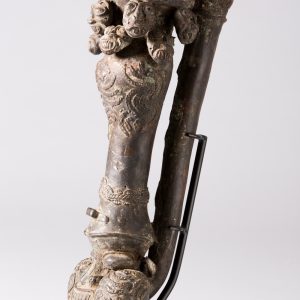
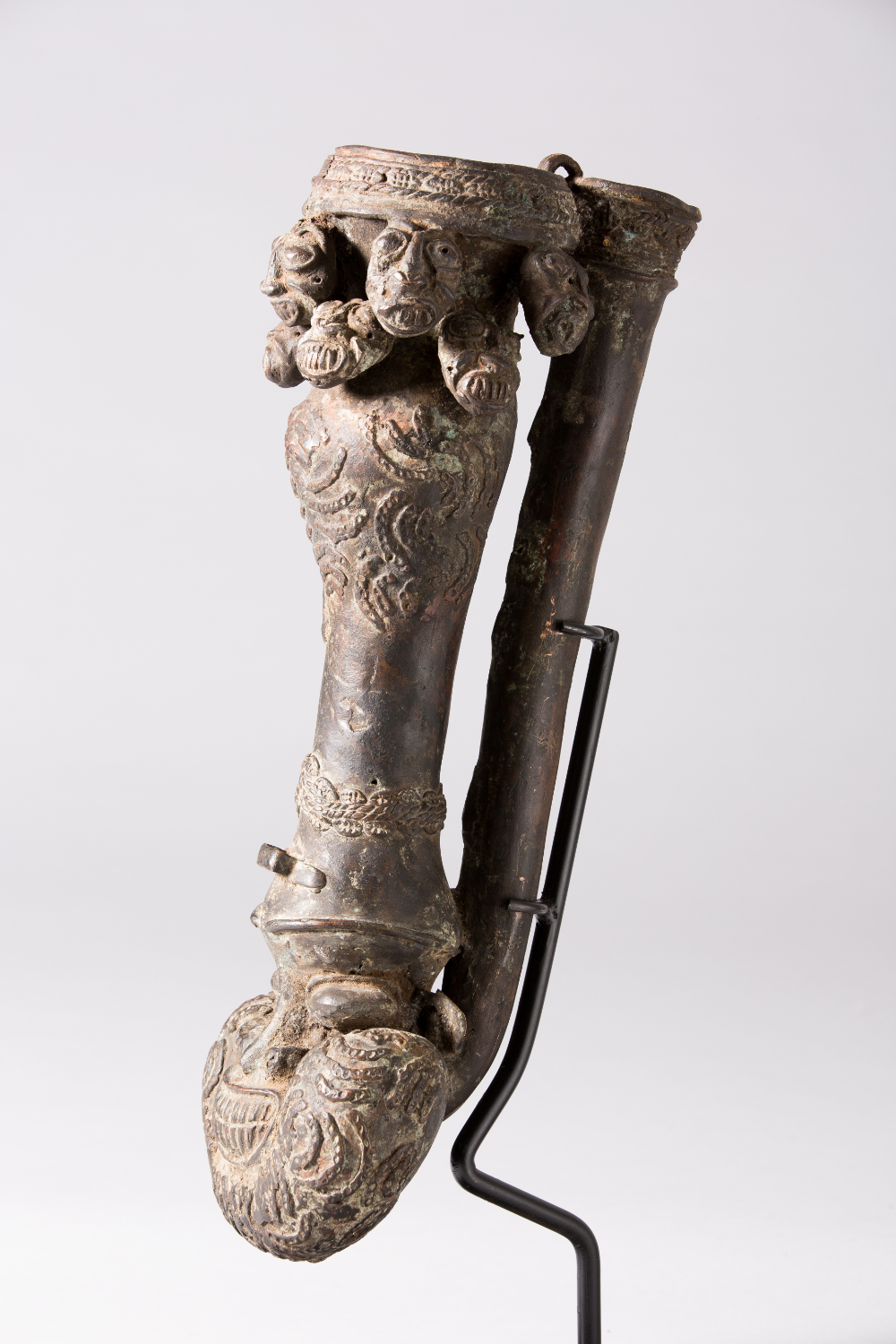
Royal Pipe
Western Grassfields: : Balikumbat
Brass, copper
19th centuryThis large royal pipe is cast in brass and copper represents the fon’s (king) face with puffy cheeks and aggressive wide eyes. On top of the pipe there is a crown of the nine important notable individuals who rule the kingdom together with the fon (king).
All nine notables belong to a Secret Society, and they are responsible for the fon’s security. They play the role of a supreme court and make jugdments among the people and also have the right to judge the fon for wrong doing and can even revoke his title. They are responsible for the funeral preparations for the deseased fon and enthronement of their successors.
-


Pipe
Northern Grassfields: Mambila
Terra cota
19th centuryThis pipe represents a mother and child, a theme seldom seen on pipes.
-
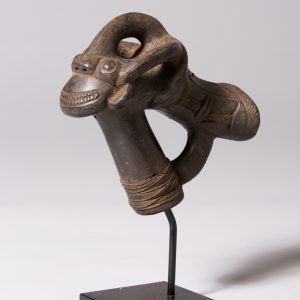

Pipe
Northwestern Grassfields: Kom
Clay
early 20th century -


Royal Pipe with Stem
Northwestern Grassfields
Brass, copper, beads, wood, banana leaves
early 19th centuryThis pipe was used to hold medicine that will assist warriors in being invisible to the battle field.
-
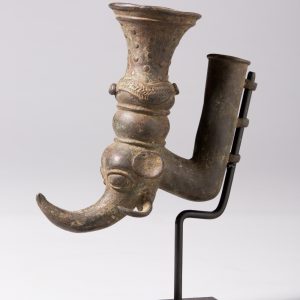
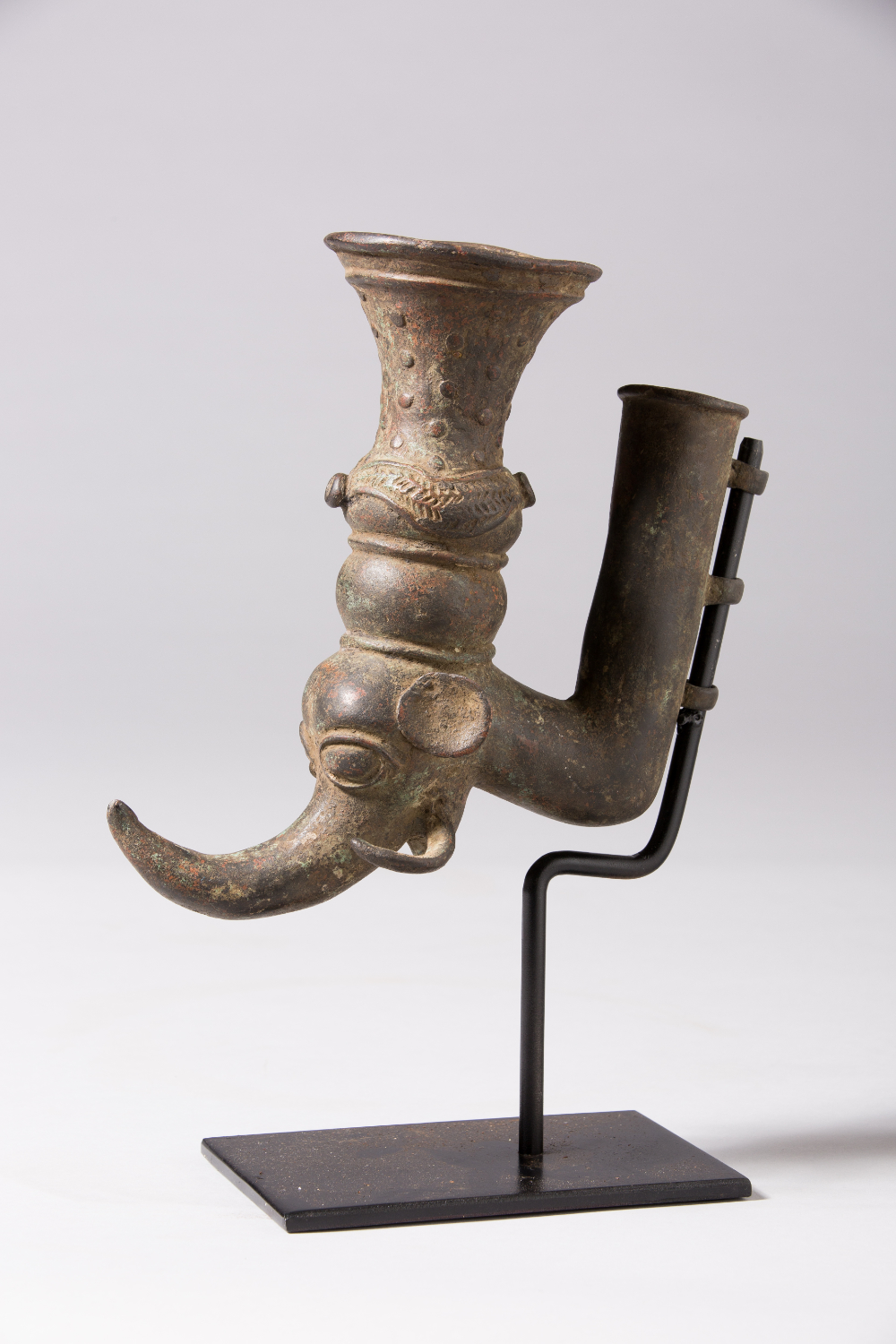
Elephant Pipe
Northwestern Grassfields, Bamenda: Bafut
Brass, copper
mid 20th century -
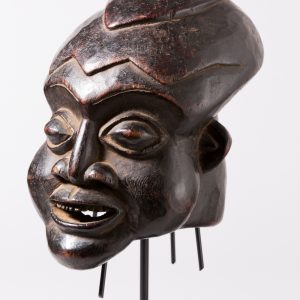
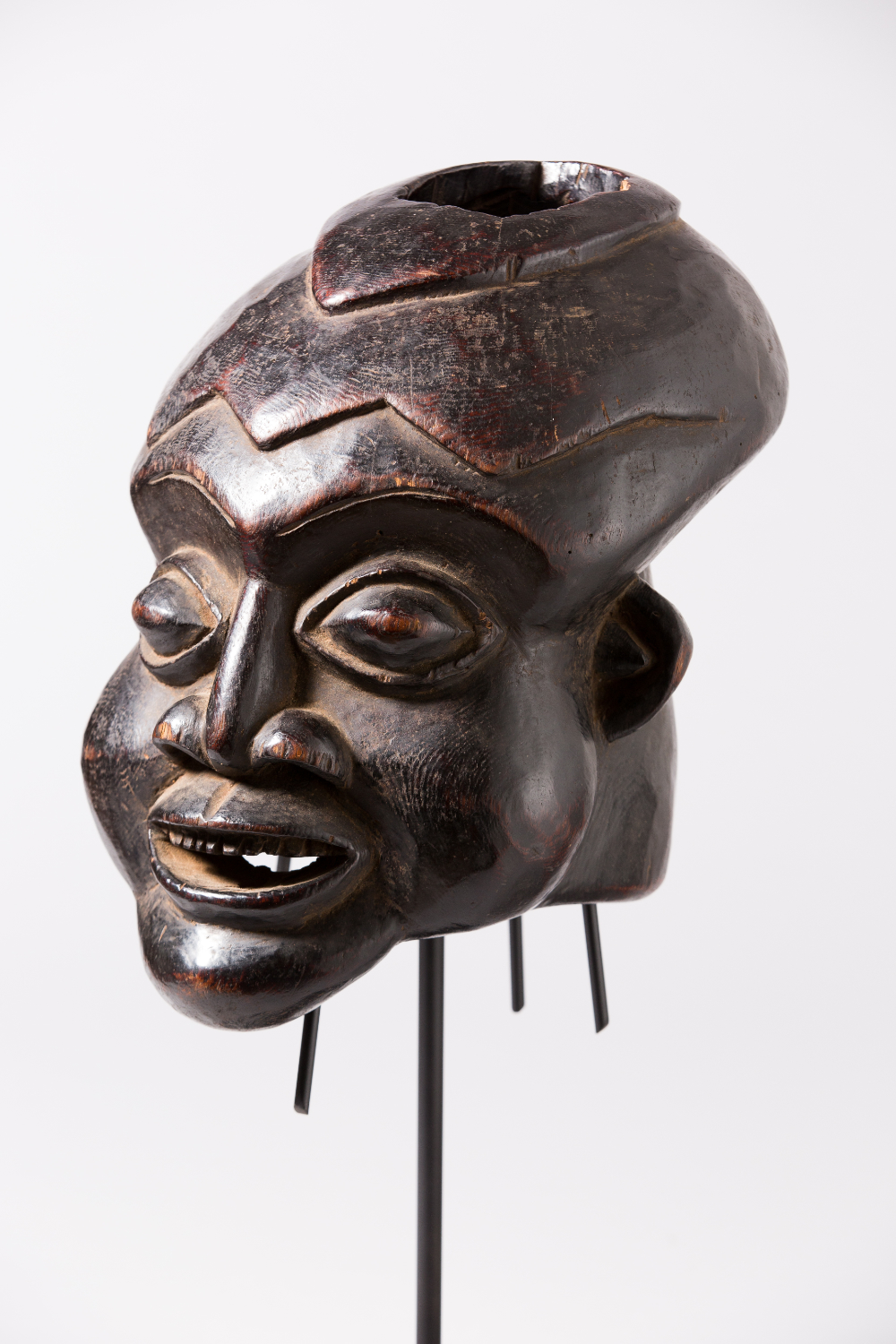
Female Helmet Mask
Northwestern Grassfields: Kom
Wood
early 20th centuryPrivate Collection · Connecticut
-
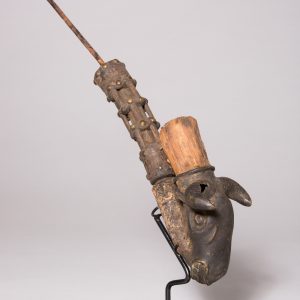

Pipe with Stem
Western Grassfield, Bamileke: Bagam
Brass, copper, wood, banana leaf
early 20th centuryThis pipe was used to both smoke and store sacrificial materials. The stopper is composed of banana leaves, the pipe itself was cast in the form of a bush cow.
-

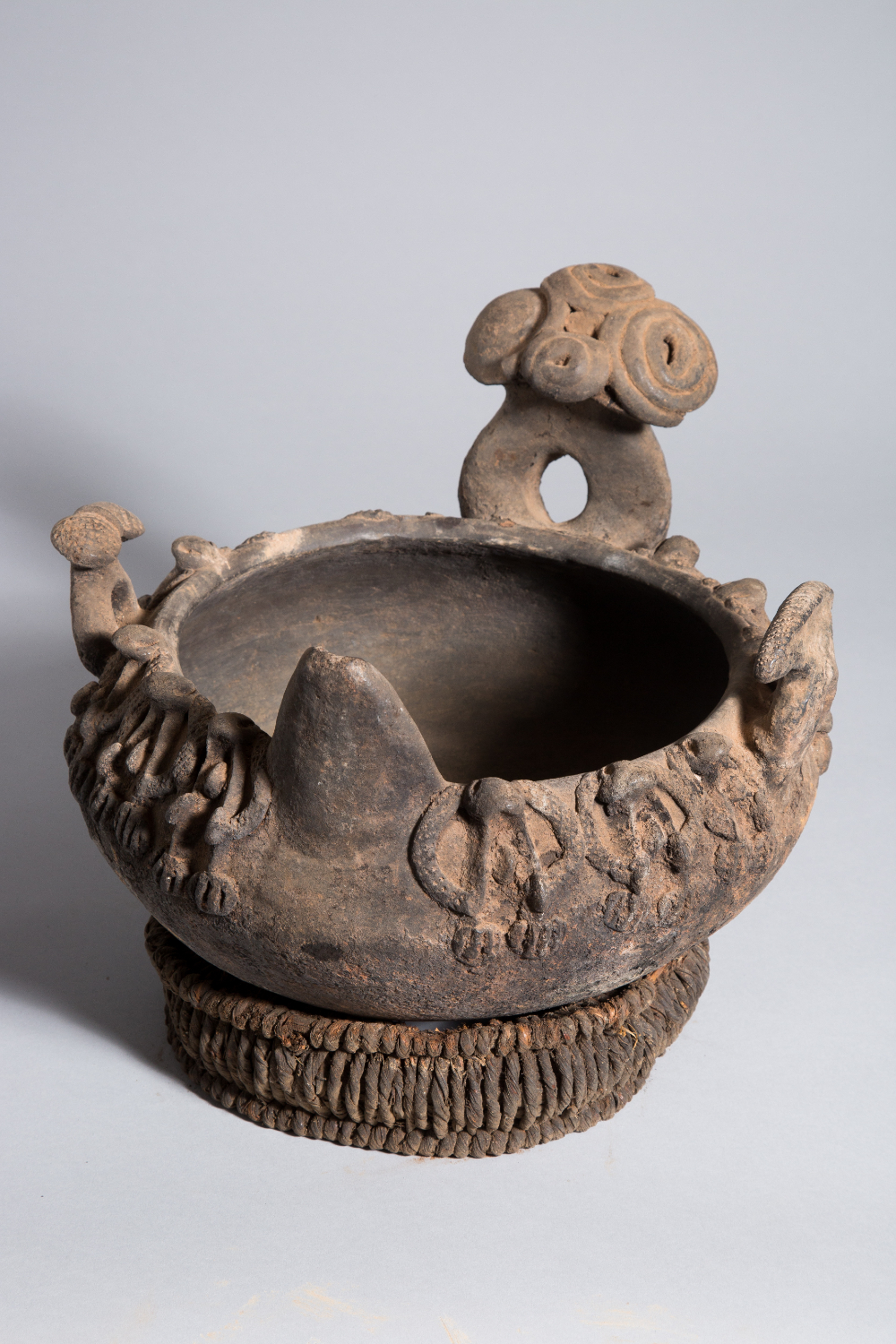
Ceremonial Vessel
Northwestern Cameroon: Kaka
Terra
cotta, cane
late 19th century to early 20th centuryThis ceremonial vessel has Secret Society members surrounding the rim of the opening. Those who are members of the powerful Secret Society are allowed to drink from it during meetings, blessing and sacrifices.
-

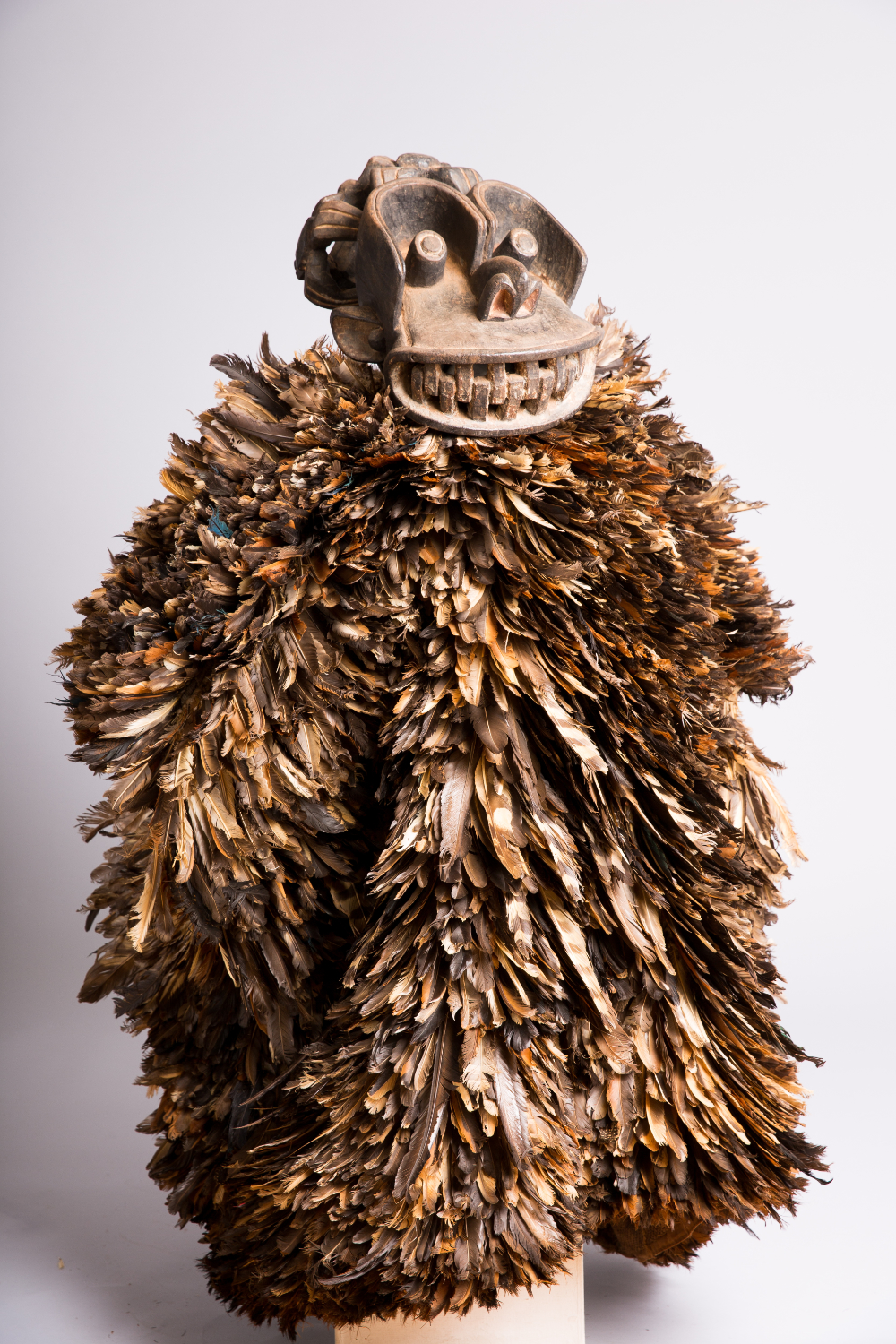
Ceremonial Costume with Mask
Northwestern Grassfields: Kom
Wood, feathers, burlap sack, pigment
19th centuryThis costume and mask was used during important ceremonies and funeral celebrations.
-

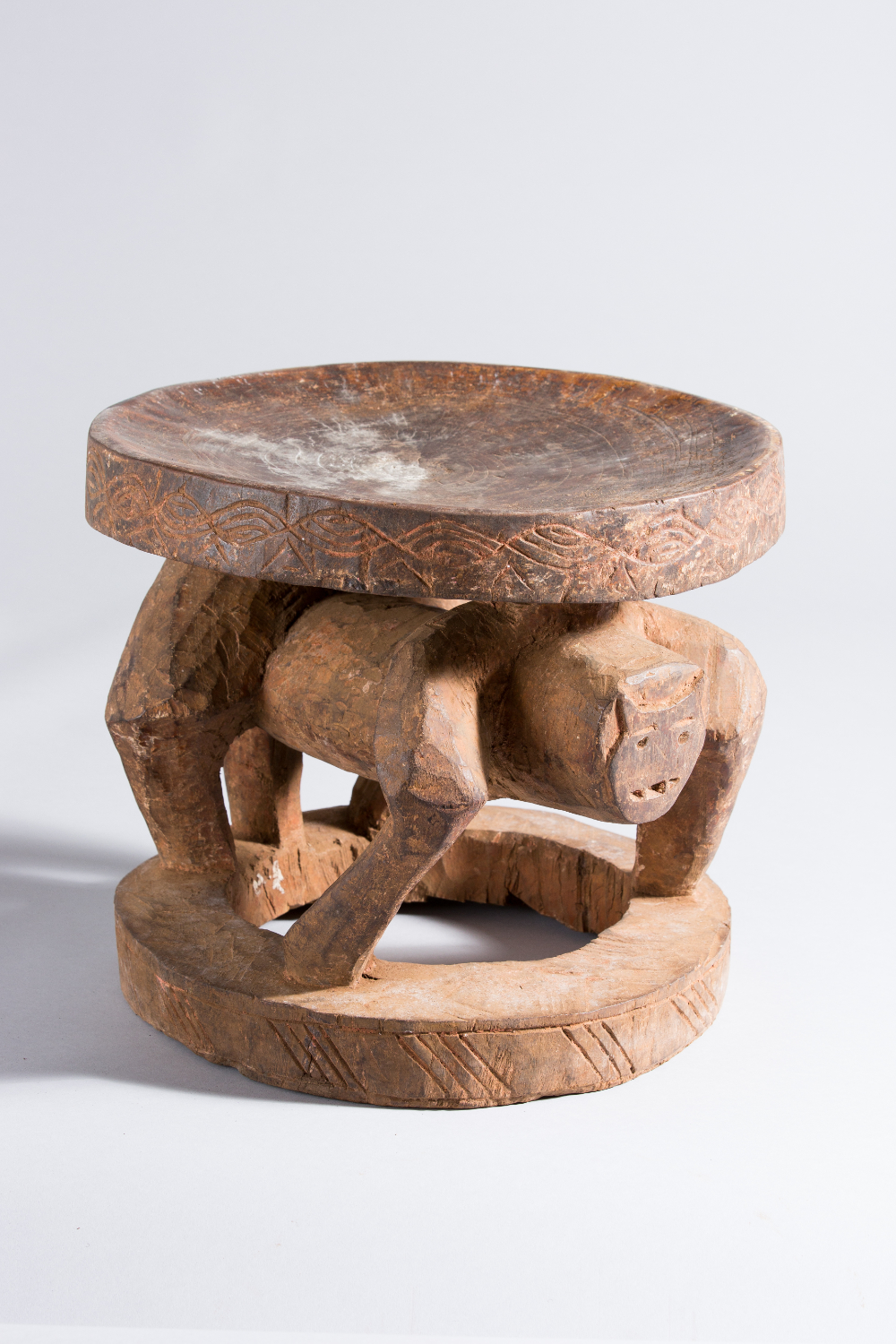
Fon's Throne
Western Grassfields, Bamileke: Bansoa Wood
early 20th centuryWooden Fon’s throne with leopard caryatid which symbolize power and authority .
-

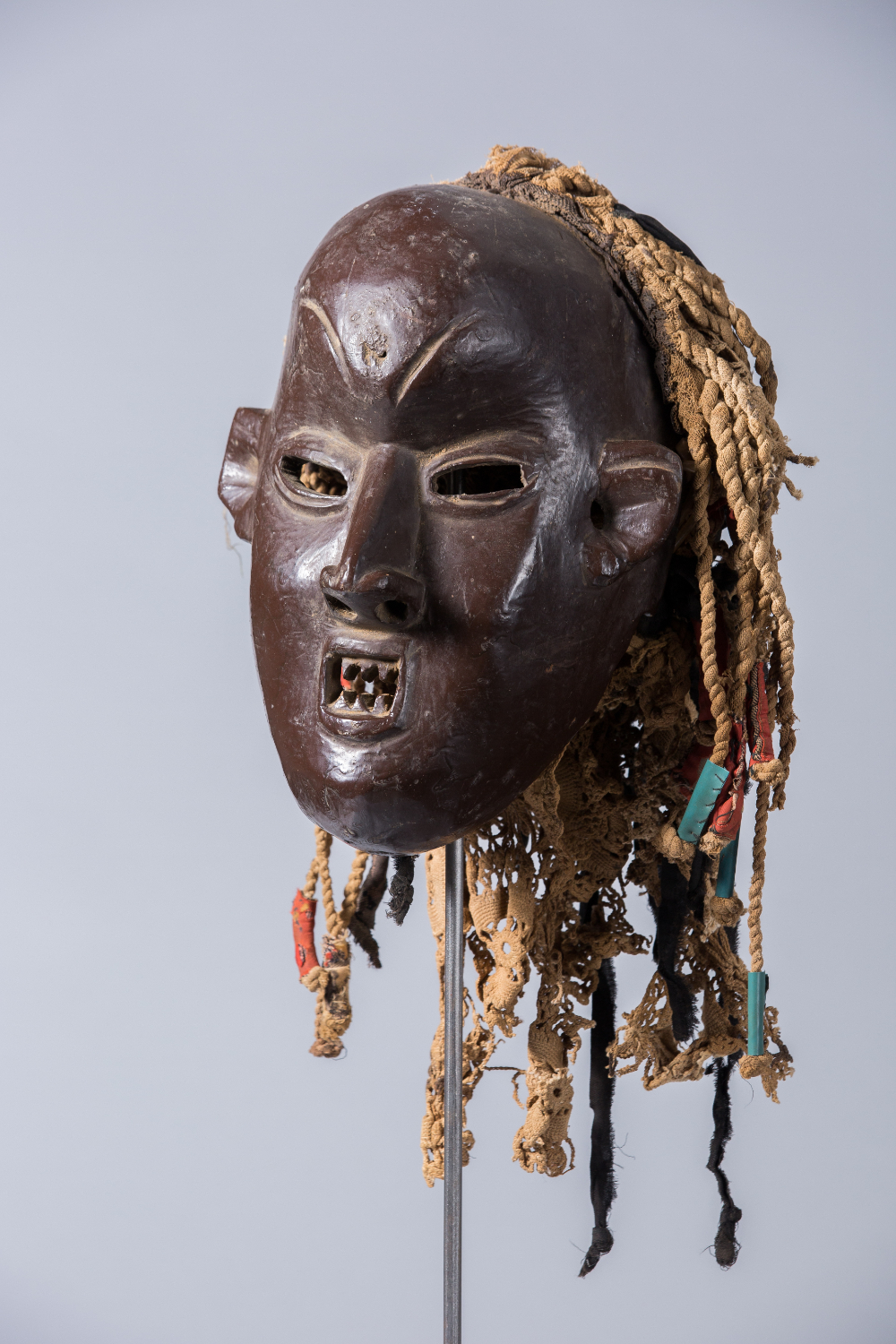
Mask, Night Society
Western Grassfields, Bamileke: Bangwa
Wood, textile, animal hide, paint
20th century -


Male Mask, Night Society
Western Grassfields, Bamileke: Bangwa
Wood, textile, pigments
early 20th century -

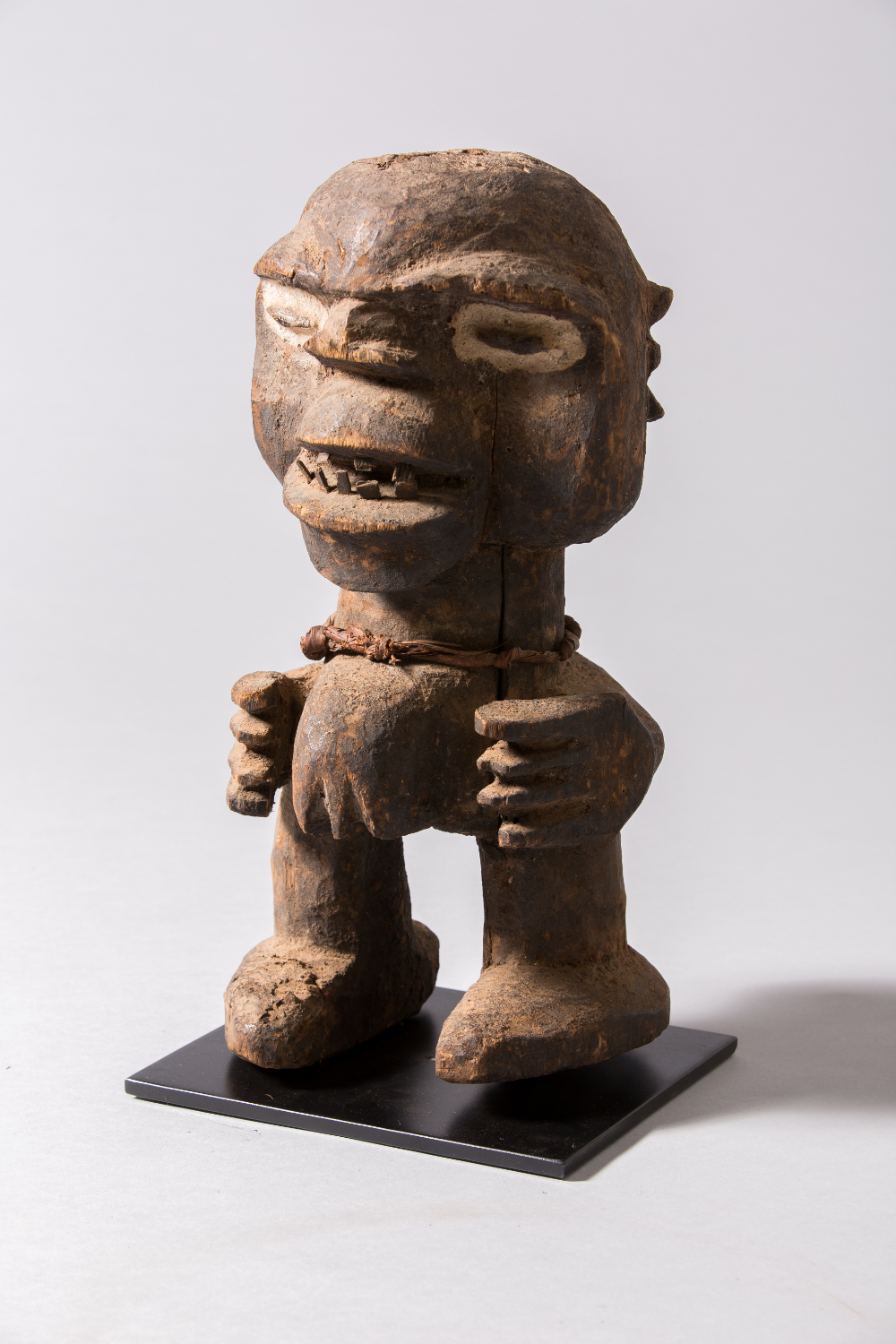
Male Figure
Southwestern Forest: Ejagham
Wood, metal, pigment, medicinal substances
early 19th centuryThis power figure was used for healing and divination.
-

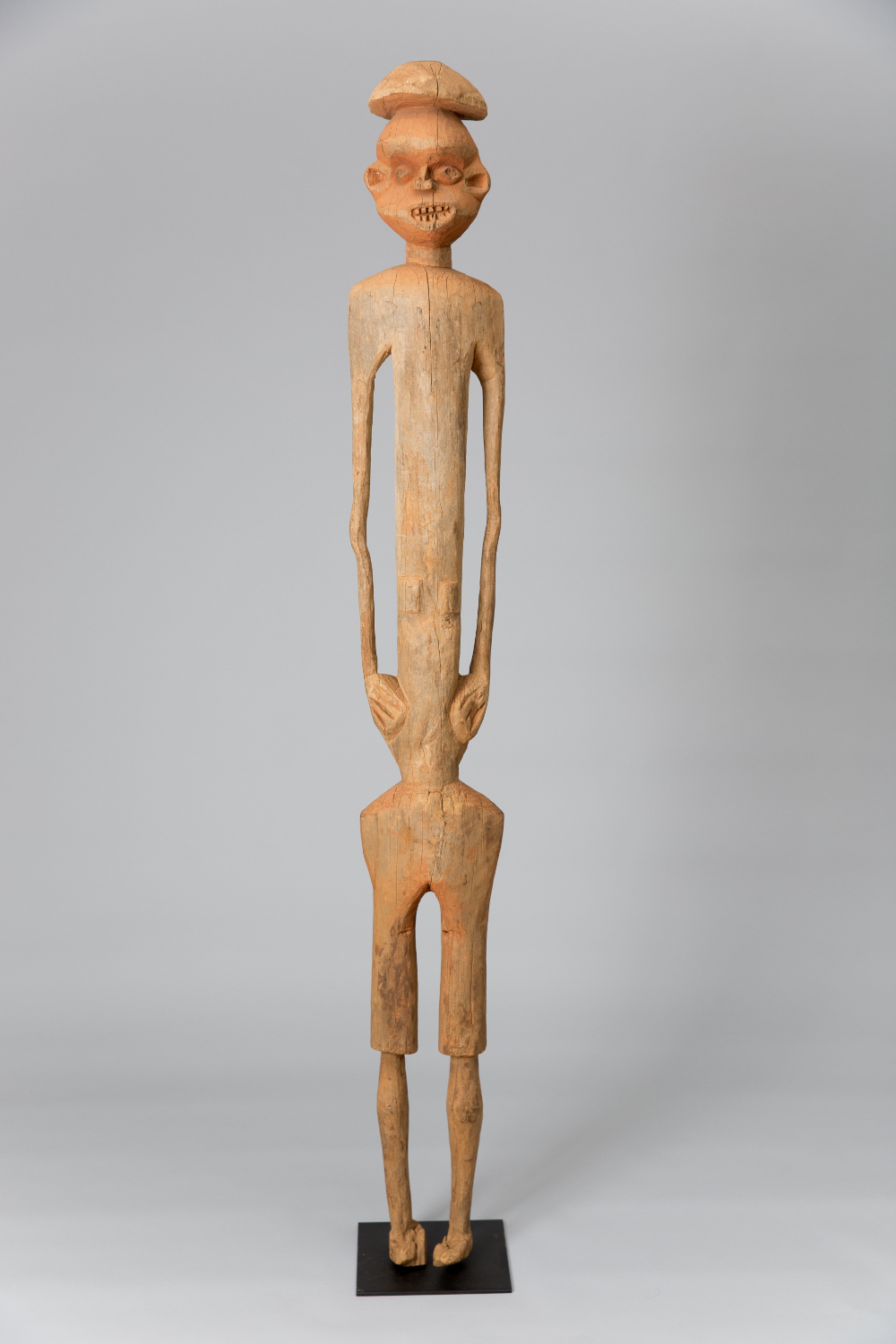
Male Figure
Northwestern Grassfields, Bamileke: Bandjoun
Wood
early 20th centuryThe attenuated figure wears a colonial cap, shirt and shorts, the typical colonial uniform. It is masterfully carved with subtle lines and volumes.
The face is classic Bamileke in its details, the mouth and eyes displaying a normal, friendly visage. It has an unusual pi- geon-toed stance. The slight- ly brown-orange color is the ubiquitous Bandjoun earth,
the figure having been standing in a courtyard. By be- ing perpetually outside exposed to the sun and the rain, the figure has developed a light wood color; a typical weathered appearance.
-
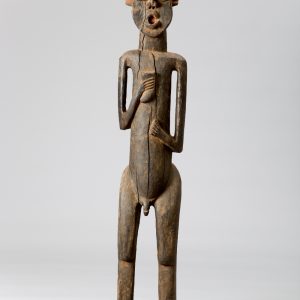

Commemorative Fon Figure
Northwest Cameroon: Nkambe
Wood, pigments
early 20th centuryNkambe King wearing royal prestige hat and holding wine cup.
-


Door Frame (one side)
Western Grassfields, Bamileke: Bandjoun
Wood
early 19th centuryThis door frame was in an entrance of a Secret Society member’s house within the palace. The six figures are participating in a ritual act. One figure on the top plays a flute and holds a rattle, and the other beats a drum. The middle two figures are in mo- tion, the female figure on the right holds her hands across her chest; a sign of talking to people who have passed from this life. She has elaborate geometric scarification on her stomach. The other figure has one hand on his pubis, the other on his cheek. The bot- tom two fragmented figures are also in ritual acts. On the top of the door frame is a go- rilla with a forceful expression,
the legs zig-zagging in rhythm with the movement and action of all the figures’ arms. On the side there are two giant lizards, head to head. In Bamileke mythology, the lizard has many meanings adding power to the com- plexity and symbolism of the door frame.
-


Female Figure
Northwestern Grassfields: Nkambe
Wood, pigments
early 20th centuryThe familiar characteristics of this style are her open mouth, wide eyes, thin arms and bent knees. She is in a ritual act. The power of her face lies in her strong mouth and large eyes – but the tri-col- or scheme of pink (Western paint), black and white are most unusual and striking. The black composition ex- tends throughout details on the entire figure; the bottom part of a post in front of a Se- cret Society’s house (nfooh)
-
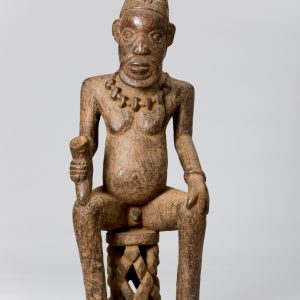

Commemorative Figure of Fon
Northwestern Grassfields: Kambe
Wood
early 19th centuryThe Fon is wearing a prestige cap and a leopard tooth neck- lace, all carved from the same piece of wood. He is holding a carved buffalo motif palm wine cup and wears a royal bangle on his left hand. Most leaders, being powerful, are depicted with large heads, this one with a mustache and beard. Such figures are kept in the royal palace and are
shown publically during special festivals. For instance, when a chief passes away, the important sculptures are taken out for the public to see, as they represent the past Fons.
-


Commemorative Queen Figure
Western Grassfields: Oku
Wood
early 20th centuryThis queen has no hair on her head because royal wom- en usually have their heads shaved, especially during fu- nerary ceremonies. This fig- ure is in a ritual act with her hands on her chest; a sign of singing – and even talking to the spirits of the dead.
-
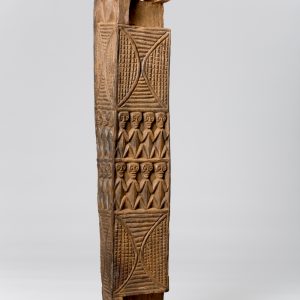
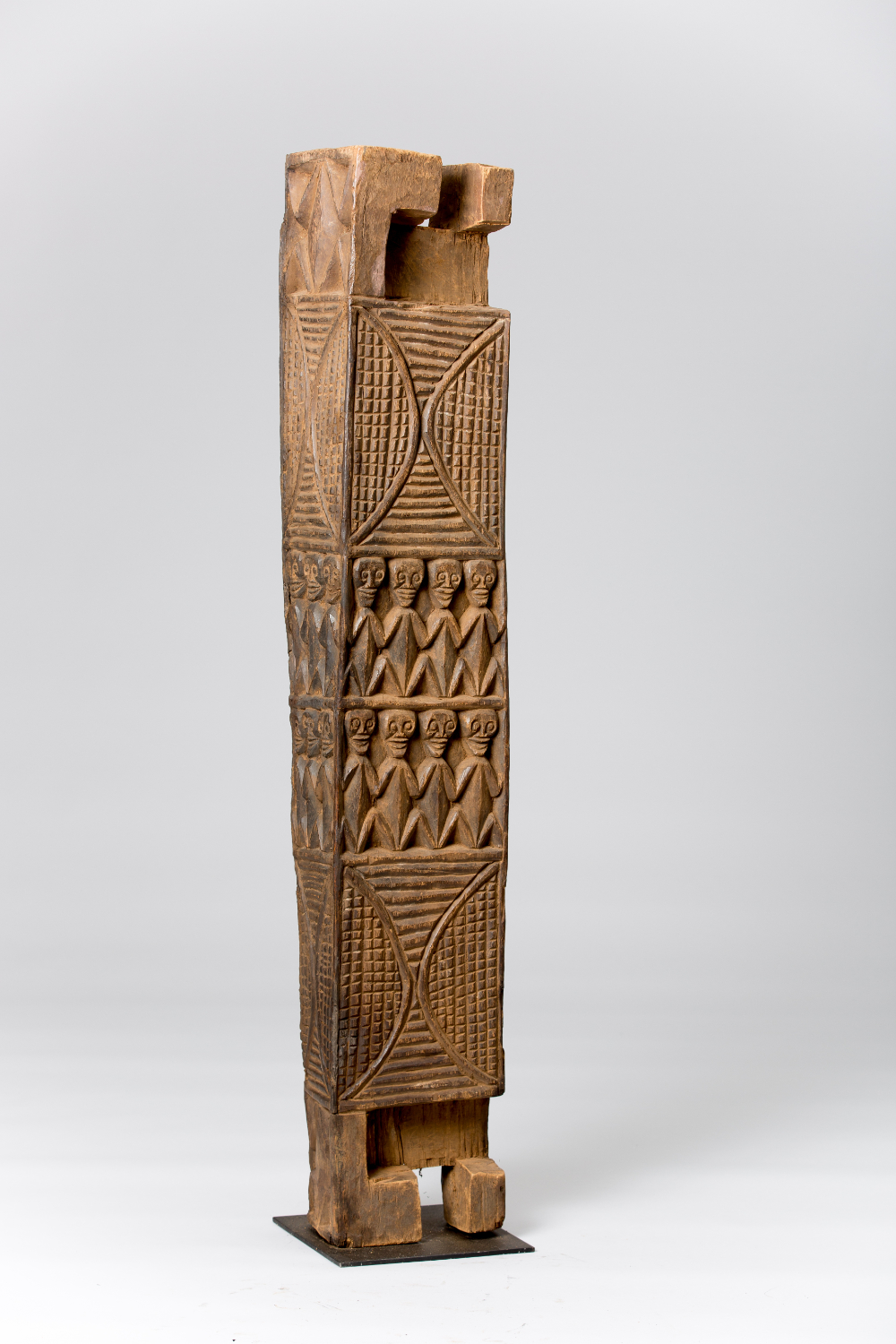
Window Frame (one side)
Northern Grassfields · Wum
Wood
Early 20th century -
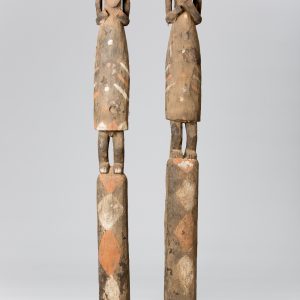
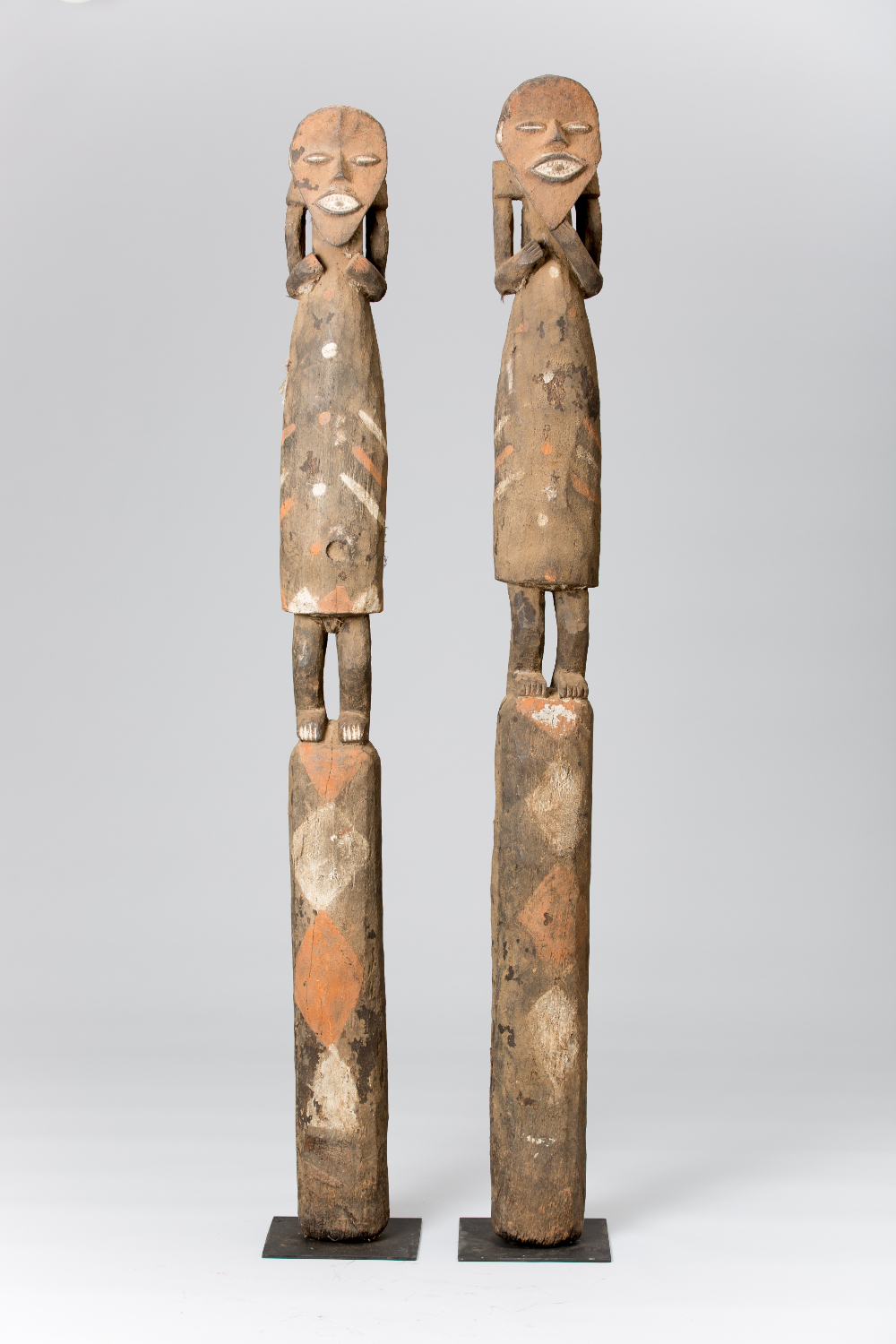
Ceremonial Posts
Northern Grassfields: Mambila
Wood, pigments, feathers and sacrificial material
early 20th century -

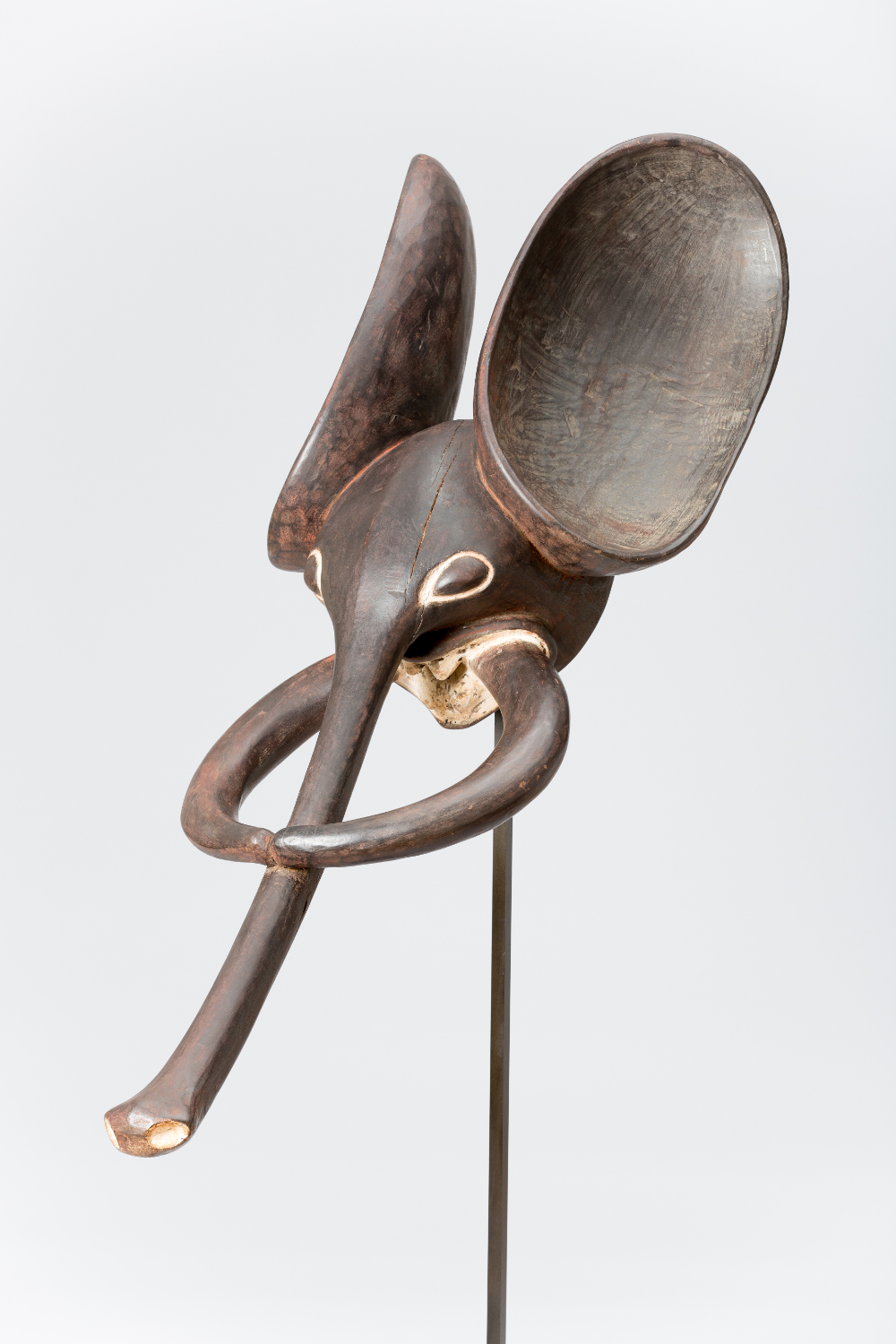
Mask
Northwestern Grassfields
Wood
19th century -
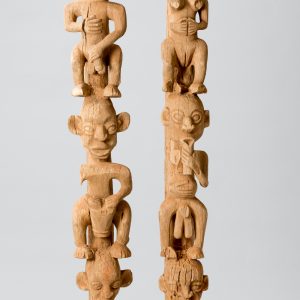

House Posts (pair)
Western Grassfields, Bamileke: Bangwa
Wood
early 19th centuryThese posts formed part of an entry portal into a Secret Society house. They are a po- tent example of ritual activity portrayed in sculpture as the figures are carved in action. The complexity of the forms fills the posts with power and a great variety of movements related to a ritual dance. The patina exhibits outside use with red Cameroon earth, erosion from rain and cracking from the sun.
-

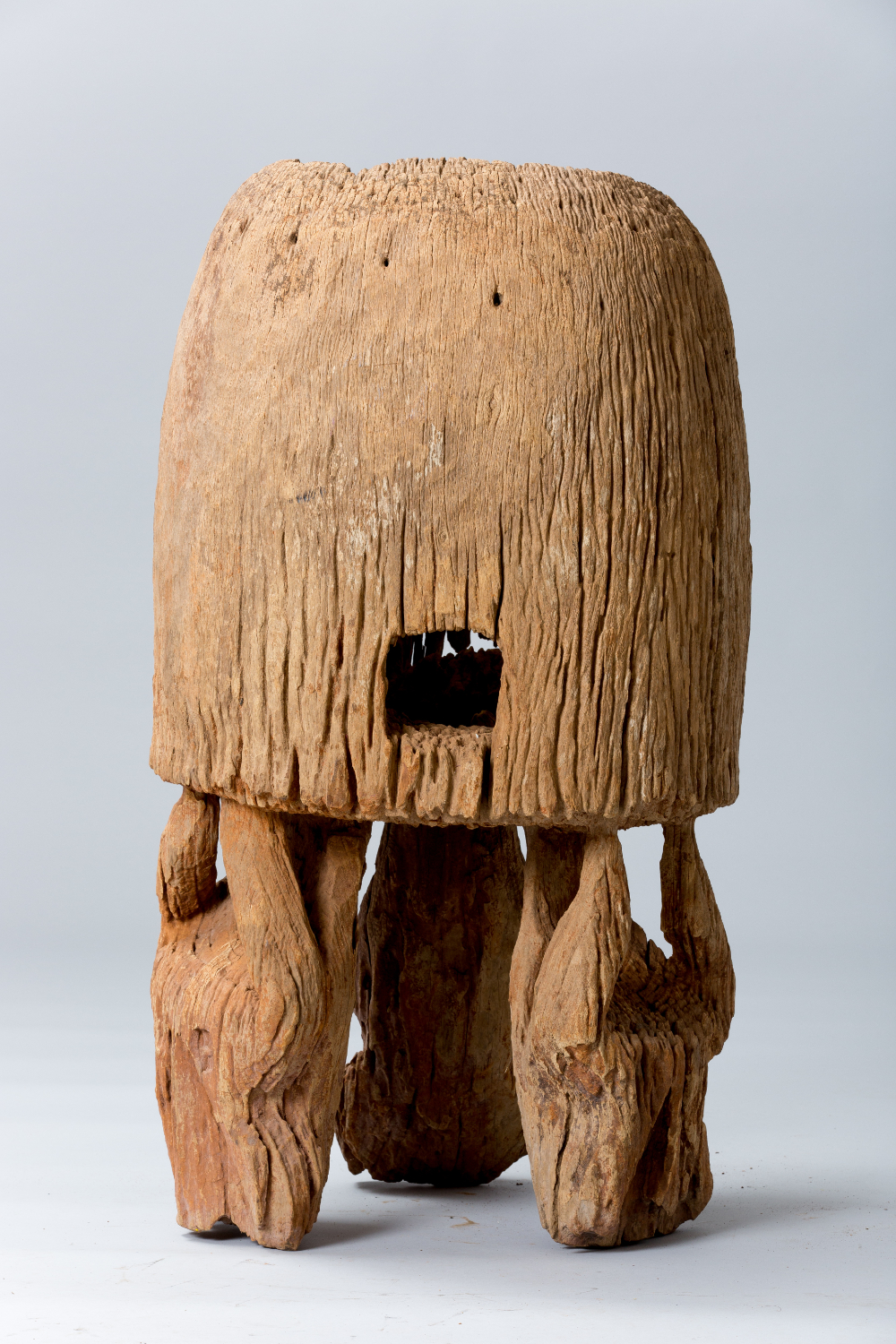
Royal Drum
Western Grassfields, Bamileke: Bangwa
Wood
early 19th century -


Slit Drum
Northwestern Grassfields: Babungo Wood
early 20th centurySymbols of power, buffalo heads are found on each end of this drum.
-
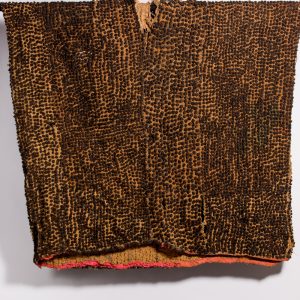

Ceremonial Hair Tunic
Northwestern Grassfields: Oku
Human hair, burlap sack
early 20th century -
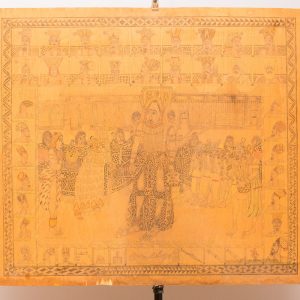

Illustration by Artist Chankouo
Eastern Grassfield, Bamum: Foumban
Graphite and paint on wood
mid-20th centuryThe illustration depicts Fon Mboumbouo during the annual festival (Nja) in front of the palace. The artsist, Chankouo, son of Moise Yeyap, a cousin of Fon Njoya. Moiseyeyap liberated the Bamum people from the injustices of Fon Ibraham Njoya.
-
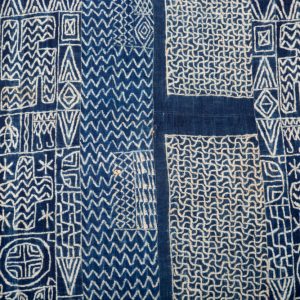

Royal Cloth
Northwestern Grassfields, Bamileke: Bamum
Cotton, pigments
early 20th CenturyThis textile, called ndop, is composed of unbleached cotton and dyed with indigo pigment, using a resist-dye technique. Originally status symbols for Bamum nota- bles, now they are prestige symbols in courts through- out the Grassfields. Large textiles are used as display cloths delineating ceremonial dance areas; they also act as backdrops for royalty and commemorative figures.